
 |
|
|
#1 |
|
All the news that's fit to excerpt
Name: newsie
Location: who knows?
Join Date: Jun 2008 Motorcycle(s): only digital replicas Posts: Too much.
|
[motorcycle.com] - 2018 450cc Motocross Shootout
 If there’s one thing we learned during our 2018 450cc motocross shootout, it’s this: When it comes to building the best 450cc motocross machine, one that excels on all tracks and in all conditions, no bike is ever perfect for everyone. Get the Flash Player to see this player. But that doesn’t mean the manufacturers ever stop trying to build the perfect beast. Depending on where they are in their development cycle, the OEMs will either tweak their existing machines or flat-out toss them and start over in an effort to claim the top rung on the 450cc motocross ladder. It’s an ongoing, repetitive process, and 2018 was no different. Hot on the heels of Honda’s surprise upset victory in our 2017 450cc Motocross Shootout with its all-new 2017 Honda CRF450R, two other manufacturers – Suzuki and Yamaha – have stepped up with new designs for the 2018 model year. 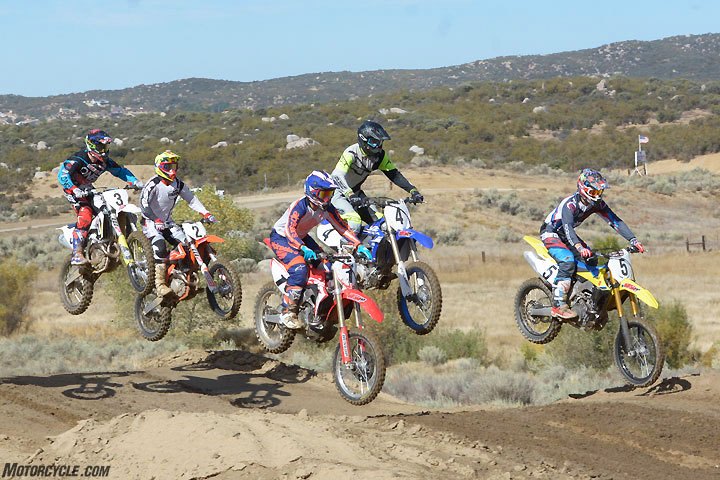 For 2018, two all-new models, the Yamaha YZ450F and Suzuki RM-Z450, came to challenge the Honda CRF450R for top honors in the 450cc motocross class. Which 450 had what it needed to claim the class title? For 2018, two all-new models, the Yamaha YZ450F and Suzuki RM-Z450, came to challenge the Honda CRF450R for top honors in the 450cc motocross class. Which 450 had what it needed to claim the class title?So, before we jump into this year’s shootout, let’s review our 2017 450cc motocross shootout results and recall why the 2017 Honda CRF450R, 2017 KTM 450 SX-F Factory Edition, 2017 Husqvarna FC 450, 2017 Yamaha YZ450F, 2017 Suzuki RM-Z450 and 2017 Kawasaki KX450F finished first through sixth respectively last year. 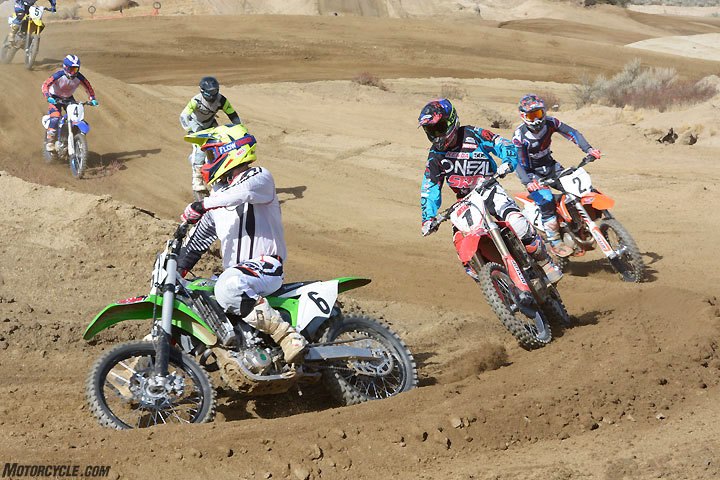 Our test crew had a lot of fun while getting down to the serious business of wringing out our six 450cc shootout competitors. Our test crew had a lot of fun while getting down to the serious business of wringing out our six 450cc shootout competitors.2017 Honda CRF450R Why it won: The 2017 Honda CRF450R blitzed the field with an all-new design punctuated by the most exciting engine performance in years. Honda also gained an edge with an all-new aluminum perimeter chassis that handled great and delivered a much more compliant ride thanks to retuned flex characteristics and a lower center of gravity. On top of that, the CRF450R sported an all-new 49mm Showa coil spring fork and a redesigned Pro-Link rear suspension that sat lower in the frame, and it performed brilliantly. What it needed for 2018: Finer tuning in the suspension department and electric start as standard equipment. Honda offered electric start on the 2017 model, but it was an expensive option that required a lot of work to install. What’s new: The 2018 Honda CRF450R now comes standard with electric start, and Honda also fiddled with the chassis flex some more by altering the shape and material thickness of the engine hangers and installing heavier, 5.0 Newton/mm fork springs and a heavier, 56 newton/mm shock spring. Honda also changed the valving at both ends in an effort to deliver the same suspension feel but with a little more hold-up in heavy braking bumps. 2017 KTM 450 SX-F Why it finished second: Because it was the more expensive Factory Edition and not the standard 450 SX-F. What it needed for 2018: Seriously, very little. The KTM matched the Honda CRF450R in virtually every category, exhibiting brilliant power, excellent handling and awesome suspension performance from its WP 48mm AER fork and linkage-equipped WP rear suspension. Its steel chassis was unflappable regardless of the terrain. Our only major complaint was that its smallish shift lever sometimes made gear changes a hassle. 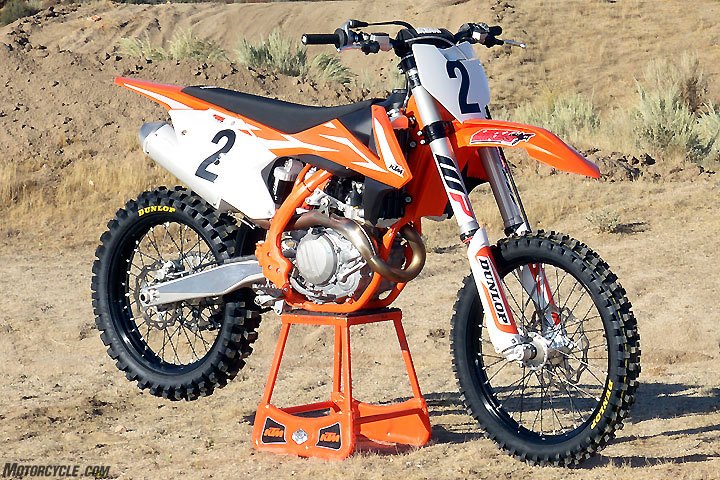 The KTM 450 SX-F finished a strong second in our 2017 shootout. This year’s entrant is not the Factory Edition but rather the production 450 SX-F, which costs less but still boasts all of the the characteristics that made the Factory Edition so formidable. The KTM 450 SX-F finished a strong second in our 2017 shootout. This year’s entrant is not the Factory Edition but rather the production 450 SX-F, which costs less but still boasts all of the the characteristics that made the Factory Edition so formidable.What’s new: Not much. This year’s shootout features the standard model, which brings the MSRP back under 10 grand, and the standard 2018 model gets a much snazzier-looking orange frame. The 450SX-F’s five-speed transmission has been massaged via the change to nitrated steel clutch plates and a new shaft bearing for increased wear resistance. KTM engineers also revised the WP AER fork to make it more compliant by going with new piston and air-seal designs, mitigating what KTM felt was some initial stiction in the fork. The fork was also revalved to give it a more fluid movement through the stroke. The mid-valve piston material is now made of more durable sintered steel instead of composite. The KTM also received a more powerful battery to make its electric starting more reliable. 2017 Husqvarna FC 450 Why it finished third: Because while the FC 450 was solid in every category, it wasn’t outstanding in any of them. What it needed for 2018: A more robust power feel. The FC 450’s engine is as tractable as they come, but our test crew complained that it simply didn’t feel fast. Since its engine is basically the same design as its sister KTM, the only problem we can see is that its composite subframe carries a different airbox design that limits air flow into the engine, giving the Husqvarna a slightly mellower power character. The FC also suffered from the same shifting gripes we had with the 450 SX-F. What’s new: Pretty much the same things that can be found on the KTM, most notably the revised piston and seal design in the WP AER fork, which was also revalved to give it a suppler feel through the stroke. The mid-valve piston material has also been changed from composite to sintered steel. 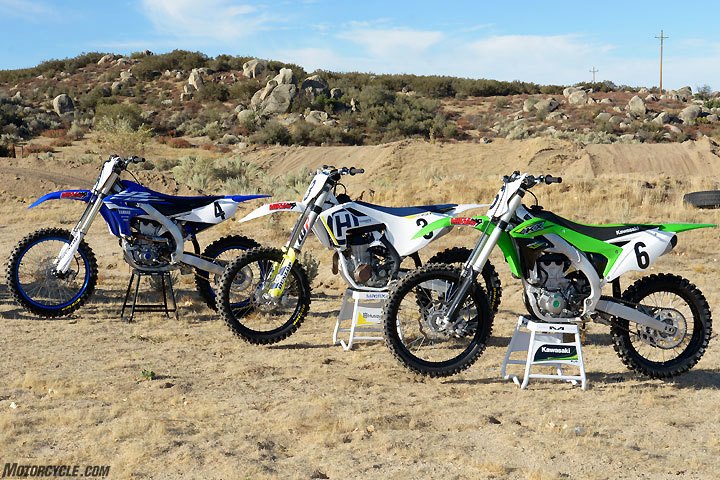 The Yamaha YZ450F is all new, while the Husqvarna FC 450 receives only a slight change to its suspension, and the Kawasaki KX450F is unchanged for 2018. The Yamaha YZ450F is all new, while the Husqvarna FC 450 receives only a slight change to its suspension, and the Kawasaki KX450F is unchanged for 2018.2017 Yamaha YZ450F Why it finished fourth: After dominating the class for a couple years, the Yamaha’s basic design aged to the point where other machines outshined it. What it needed for 2018: The one thing it didn’t need was more power or better suspension, as the YZ450F was the brawniest-feeling bike in the class, and its KYB Speed Sensitive System (SSS) fork and KYB shock were the best suspenders in the class. That said, it could feel a bit brutish, and, coupled with a wide-feeling chassis that tended to want to stand up in the corners, the YZ was simply more of a chore to ride fast late in a moto. What’s new: Everything! Yamaha knew that its existing YZ450F was starting to lose ground in the class, and the tuning-fork brand not only came out with an all-new design 2018 YZ450F from stem to stern, it introduced some revolutionary new technology along the way. Starting with an all-new, electric start engine that is tuned to spread the Yamaha’s generous power output farther across the rev range, an all-new bilateral beam chassis that is narrower than the previous version, all-new bodywork and the latest generation of its KYB SSS suspension. Where Yamaha really advanced the YZ450F, however, was in its tuning capability. Yamaha’s Power Tuner iOS and Android app allows the rider to wirelessly tune the engine’s ECU and data log and share a mountain of information with the use of an Apple or Android smartphone. 2017 Suzuki RM-Z450 Why it finished fifth: Because even though we still liked the RM-Z450, we had to face reality. The Suzuki packed a user-friendly engine that simply didn’t have the top-end punch of many of its competitors in a chassis that turns like a corkscrew but is extremely rigid and harsh in the bumps. Suspended up front by a Showa TAC air fork that has arguably never been the best in its class, the RM-Z450 was woefully behind the Honda and Yamaha coil-spring forks in overall performance. 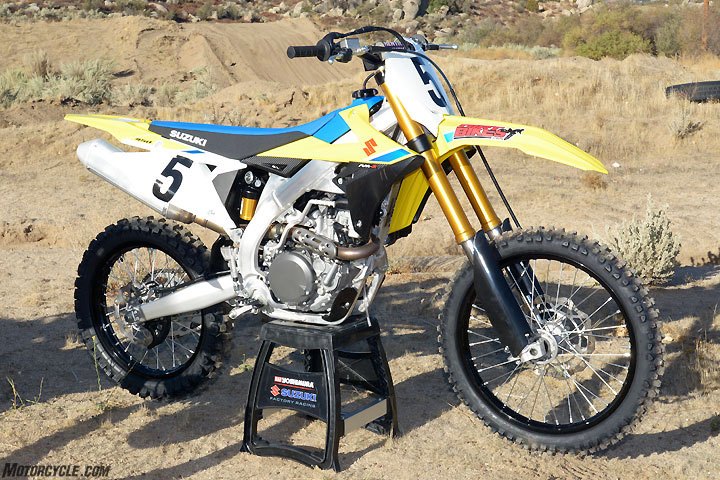 The 2018 Suzuki RM-Z450 receives an all-new chassis and suspension and serious motor updates, but no electric start. The 2018 Suzuki RM-Z450 receives an all-new chassis and suspension and serious motor updates, but no electric start.What it needed for 2018: A serious redesign. What’s new: It’s a serious redesign. Not an all-new one, but significant nonetheless. The 2018 Suzuki RM-Z450’s engine architecture is unchanged from the 2017 model, but Suzuki invested significant R&D into getting it to perform better than the 2017 model by updating the cylinder head and airbox for better flow, switching to a more radical intake camshaft profile, combing through the fuel injection to increase power and deliver even better throttle response, and making some minor internal changes, such as changing the piston to increase reliability. Even better news, however, is that the engine is housed in an all-new, twin-spar aluminum chassis that is smaller, lighter and shorter than the 2017 model. Suzuki also ditched the Showa air fork in favor of a new 49mm Showa coil-spring fork, and a new Showa BFRC (Balance Free Rear-Cushion) shock absorber now holds up the tail. An oversized 270mm front brake disc has been fitted to make the RM-Z450 more competitive in the braking department, and all-new bodywork also gives the RM-Z450 a much sleeker appearance than the ’17. 2017 Kawasaki KX450F Why it finished sixth: Because it left too much on the table. The Kawasaki KX450F clearly showed a lot of potential, but it lacked the top-end punch of many of its competitors, and its Showa SFF-Air TAC air fork simply wasn’t to our liking. What it needed for 2018: Barring a complete redesign, a revamp to the existing engine to increase its top-end charge and a swap to a coil spring fork or – at the very least, to the Showa SFF fork that is found on the Kawasaki KX250F – would have helped the Kawasaki in our opinion. What’s new: Nothing. Kawasaki obviously spent most of its effort in redesigning the 2018 KX250F. The KX450F will have to wait another day for more love by Kawasaki engineers. The Call to Cahuilla Creek Our test crew ventured to Cahuilla Creek MX for our 2018 450cc Motocross Shootout. Cahuilla Creek’s fast, flowing layout and sandy soil was sure to force each manufacturer to prove its horsepower, handling and suspension in the face of its peers. We also weighed and measured each contender and spent a day at Mickey Cohen Motorsports to gather dyno data so we had a clearer picture of our seat-of-the-pants impressions (surprisingly, we found that the dyno tells a very different tale than our butts). Once again, to force the riders to really think through their impressions, we mandated the use of Motorcycle.com’s comprehensive scorecard to rank the bikes according to a vast number of categories. The results were interesting, to say the least. 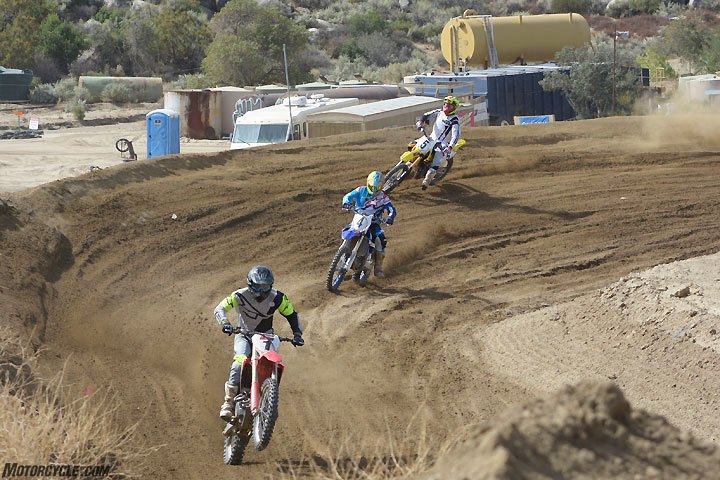 Our 2018 shootout took place on the fast, flowing and sandy Cahuilla Creek MX track in Anza, California. Our 2018 shootout took place on the fast, flowing and sandy Cahuilla Creek MX track in Anza, California.Just like last year, we stuck with five key categories: Engine Performance, Suspension Performance, Handling, Braking Performance and Ergonomics. The MO Scorecard also assigns objective values to such items as price, pounds per horsepower and pounds per lb.-ft. of torque. On the subjective side, a laundry list of additional items such as model features, cool factor and grin factor are all considered when determining the class champion. Engine Performance When it came to power delivery, one machine stood out among the six machines in our 2018 450cc motocross shootout, the Yamaha YZ450F. The 2018 model doesn’t hit as hard as the 2017 did, and yet it feels faster overall thanks to Yamaha’s efforts to make the motor smoother and less tiring to the rider than the previous version. The YZ450F’s, rearward-inclined, fuel-injected, DOHC, 449cc engine boasts intake and exhaust cams with more lift and more duration, which shifts the power higher into the rev range. 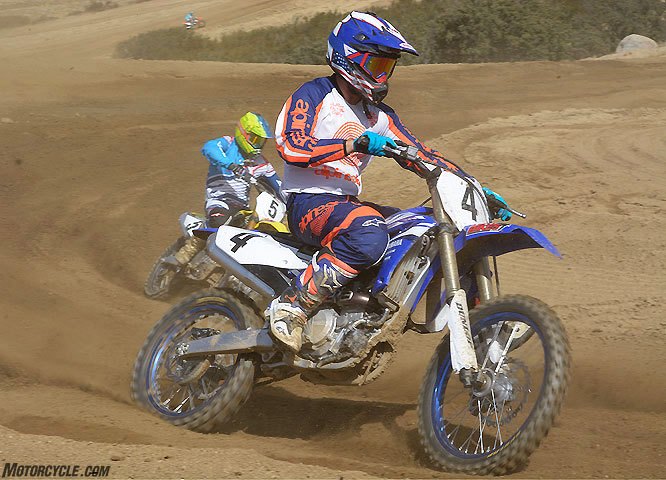 There was no question in our test riders’ minds that the Yamaha YZ450F makes the best power in the class. The latest generation of the YZ’s rearward-inclined DOHC Single pulls as hard as ever but isn’t as abrupt as last year’s engine performance category winner. There was no question in our test riders’ minds that the Yamaha YZ450F makes the best power in the class. The latest generation of the YZ’s rearward-inclined DOHC Single pulls as hard as ever but isn’t as abrupt as last year’s engine performance category winner.The Yamaha still comes off the bottom with plenty of authority, and it maintains that feel as it pulls through the middle and into its healthy top-end with plenty of overrev. But it doesn’t feel as peaky as the 2017, and that makes it even easier to ride. On the dyno, we expected the Yamaha to make the most horsepower and the most torque in the class, but it didn’t. The YZ pumps out 52.3 rear wheel horsepower (rwhp) at 9900 rpm and 32.0 lb.-ft. of torque at 7800 rpm, and every bit of it useable, according to lead test rider Ryan Abbatoye. “The Yamaha has the best power to me out of all of them,” Abbatoye said. “It’s strong and crisp right off the bottom, and its throttle response is the best in the class. It isn’t too much. It’s really smooth off the bottom, and it never seems to run out of top end. It’s pretty seamless all the way through the rev range.” That was a sentiment echoed by most of our group, including new recruit Ryan Smith, who campaigns in the AMA National Hare & Hound Championship Series. “It never flattens out,” Smith said. “It just keeps getting stronger. It’s a lot better than last year’s in that it isn’t as jerky. It’s really strong.” Test crew regular Nick Stover added, “I’d say it’s the best in class. It’s really exciting, but that could be because it’s actually hooking up and not spinning the tire. It probably has the best transmission in the class, too — very smooth with no hang-ups. The clutch is very smooth as well. It’s a heavier pull than the KTM but not as heavy as the Honda.” 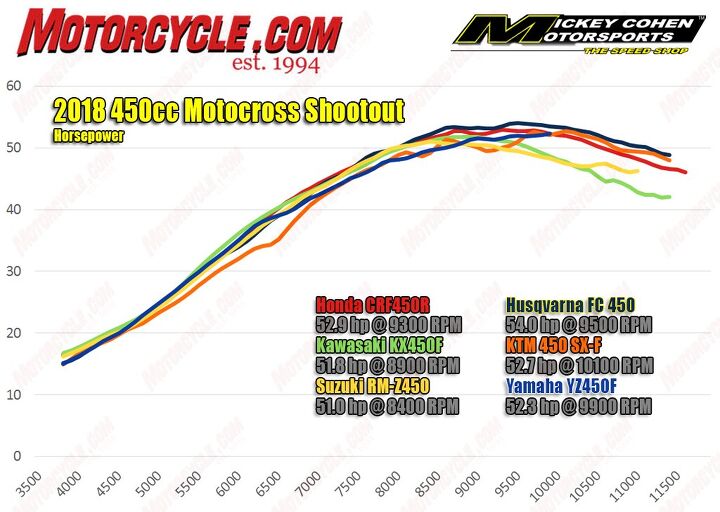 Just like last year, the KTM 450 SX-F was also unanimously praised by our test crew. The 450 SX-F’s 449.9cc, liquid-cooled, SOHC motor doesn’t come off the bottom with as much grunt as some of the other bikes in the category, but it is smooth and exciting as it marches toward its turbo-like top-end. On the dyno, the KTM delivered even more rwhp than the Yamaha, 52.7 at 10,100 rpm, while churning out 32.0 lb.-ft. of peak torque at 8000 rpm. On the track, the KTM’s rev-licious top-end drew a lot of praise from our test riders at Cahuilla Creek. “The KTM is very strong and smooth,” Stover said. “It feels really, really good. It’s exciting power. It’s more of a top-ender. It’s not super strong down low, but it builds and builds. There’s a hit in the middle, and it continues to pull through the top-end overrev.” Smith echoed the sentiments of the crew when it came to KTM’s power character. “It’s more aggressive than the Husky, but it doesn’t hit as hard as the Honda and the Yamaha, and it pulls harder through the middle up to the top-end,” he said. “The motor revs really well. I had no issues with the KTM’s hydraulic clutch. It was more to my liking than the Husky’s because you don’t have to pull it in as far to feather the clutch.” 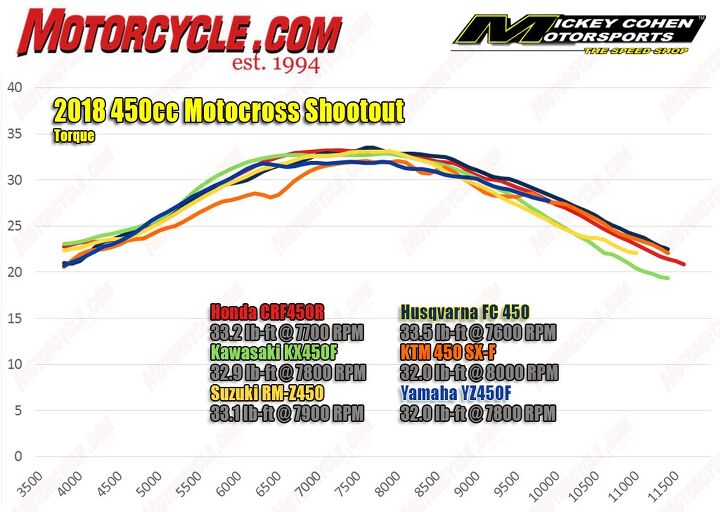 The Honda CRF450R was on the favorable end of the mix in our 2018 450cc motocross shootout, as well, ranking third among most of our test crew, who really appreciated not having to try and kick-start the CRF engine, a tricky chore on the ’17 model. Honda really succeeded in creating a more exciting powerplant for the CRF450R last year, and the 449cc, liquid-cooled, Unicam engine is still cool, with snappy throttle response, excellent low-end burst and solid mid-range and top-end thrust. The Honda makes more torque than the KTM and the Yamaha, with 33.2 lb.-ft. at 7700 rpm, and it’s available sooner than the YZ or the SX-F, which contributes to the CRF’s robust character as it continues to build to an rwhp peak of 52.9 horsepower at 9300 rpm. Like the Yamaha and the KTM, the Honda also maintains a good spread of power past its peak, which makes it fun to ride. “The Honda has a strong hit off the bottom, and it carries that through the midrange, which means you don’t need to rev it out much because it is already so strong,” Smith said. “The top-end overrev is really good as well. It’s very snappy and responsive. There’s no lag. I did have the motor flame out on me a few times — it was the only bike I had that happen to me — and even with the electric start, it seemed like it was hard to start.” However, all of our test riders had issues with the heavy pull of the Honda’s cable-actuated clutch. “The CRF450R has the heaviest clutch pull of any of the bikes in the class,” Abbatoye said, with Stover adding, “The clutch pull is stiff, but engagement feels real good. Nothing stands out about the Honda’s five-speed transmission. It isn’t buttery smooth or too notchy.” 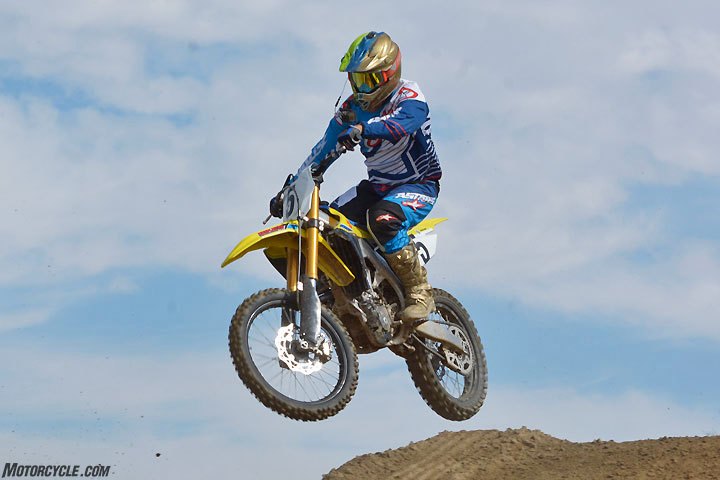 The 2018 Suzuki RM-Z450 makes the least horsepower and is the heaviest bike in the class despite not having an electric-start feature. Still, the Suzuki produces a harmonious blend of power, torque and throttle response that makes it easy to ride fast. The 2018 Suzuki RM-Z450 makes the least horsepower and is the heaviest bike in the class despite not having an electric-start feature. Still, the Suzuki produces a harmonious blend of power, torque and throttle response that makes it easy to ride fast.The RM-Z450 clearly benefitted from Suzuki’s engine upgrades, although not enough to vault it to the head of the class. Although not by much, the RM-Z’s revised 449cc, liquid-cooled, DOHC engine makes the least power in the class, but it also recorded the third highest peak torque figure, proving that you don’t have to make the most peak power to attain success in the 450cc ranks. With 51 rwhp on tap at 8400 rpm and 33.1 lb.-ft. of torque at 7900 rpm, the Suzuki is still no rev monster. Instead, it appears as if the RM-Z450 engineers focused on simply enhancing the power character that was already there. That includes virtually flawless throttle response and a linear pull that doesn’t fall on its face like the 2017 RM-Z450 did. It gives the RM-Z more breath between gears, which means that you don’t have to row its five-speed gearbox nearly as much. “The RM-Z450 has a good amount of power off the bottom, good throttle response and good pull through the mid-range and up to the top end,” Smith said. “It never left me looking for more. It feels closer to the KTM in terms of overall hit. You can nail the gas and break it loose, or you can get it to hook up really easily. It’s really flexible.” In fact, most of our test riders were surprised by just how improved the RM-Z450 engine really is. “It surprised me for sure,” Stover said. “It’s so much better than the ’17. It’s actually exciting to ride now. The motor matches the chassis.” Abbatoye added that the Suzuki engine feels better than it has in years. “The Suzuki used to have such a short power range, where it ran out super quick, but now it feels like it pulls longer, with more mid-range and top-end,” Abbatoye said. “The new engine definitely solves the problem that the old one had where it ran out of steam on top. You don’t have to shift the 2018 nearly as much.” 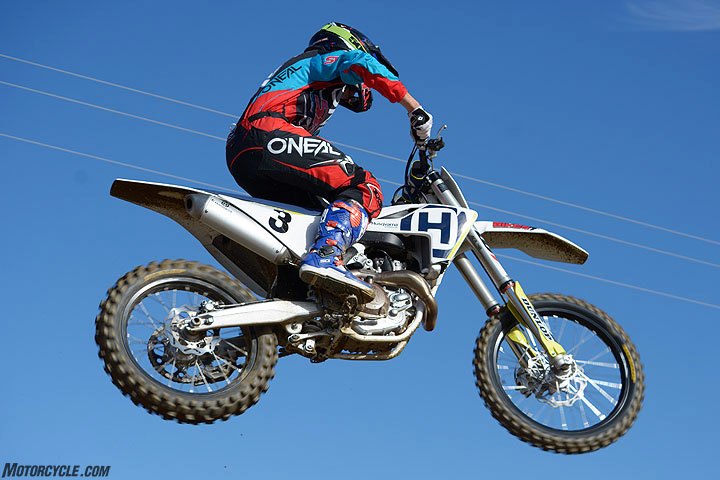 The 2018 Husqvarna is a real head-scratcher. Our test pilots swore it was the most mellow monster on the track, and yet it outperformed every bike in the class on the dyno. The 2018 Husqvarna is a real head-scratcher. Our test pilots swore it was the most mellow monster on the track, and yet it outperformed every bike in the class on the dyno.Considering just how close the Husqvarna FC 450 is in overall engine tuning to the KTM 450 SX-F, its fifth-place ranking in the engine performance category of our 2018 450cc motocross shootout is a bit of a head-scratcher that becomes all the more perplexing when you consider that the Husqvarna was also horsepower and torque king during our dyno test. The Husky’s 449.9cc liquid-cooled, SOHC single made 54 rwhp at 9500 rpm and a whopping 33.5 lb.-ft. at 7600 rpm, with its peak torque coming sooner in the rev range than any other bike in this comparo. So, what’s the deal? According to our dyno dude, Mickey Cohen, the “problem” is that the Husqvarna’s fuel-injection is so smooth and its torque curve is so linear that it might not feel all that exciting on the track. Indeed, the Husqvarna fooled all of our test crew, who panned it for its lack of snap. “It just feels a little soft,” Stover said. “I can’t believe it makes the most power. It just doesn’t feel like the mid-range has the hit of the others, and it doesn’t give you the impression that it is making big power. It just drives forward, but it doesn’t light up the rear tire or blow up berms or anything like that.” “It isn’t a rocket ship, and it feels like it doesn’t want to rev out,” Abbatoye said. “It’s definitely tractable. It doesn’t want to spin the wheel everywhere. It would be good power for off-road racing.” It was no surprise, however, that the Kawasaki KX450F trailed the others when it came time for our test riders to pick the engine performance hierarchy. Last year we noted the Kawi’s exhaust note appeared to signal that it was ready to throw down in the power sweepstakes, but instead we determined that its 449cc, liquid-cooled, DOHC engine didn’t have the bite to match its bark, particularly from the mid-range onward. Our 2018 test unit delivered 51.8 rwhp at 8900 rpm and 32.9 lb.-ft. of peak torque at 7800 rpm. Those aren’t the lowest numbers in the class in either category, and in fact the Kawasaki delivers the fourth-best torque figure. Still, out on the track, our test riders simply wanted more top-end power out of the KX engine than it was willing to deliver. 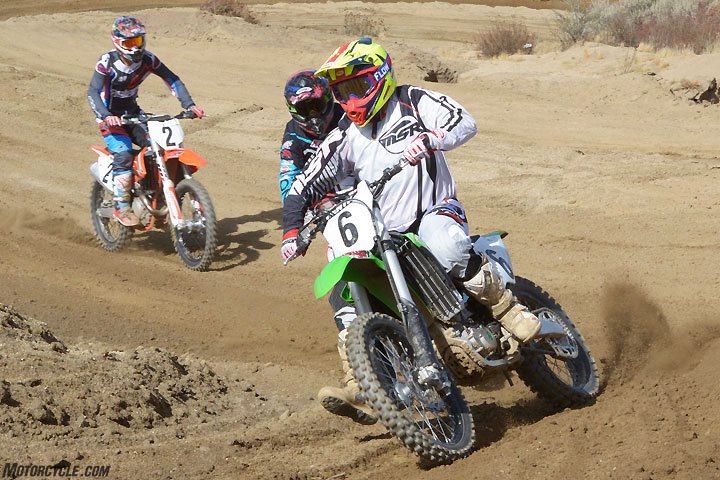 The 2018 Kawasaki KX450F isn’t slow, but it still lacks top-end thrust compared to its competition. The 2018 Kawasaki KX450F isn’t slow, but it still lacks top-end thrust compared to its competition.“The KX450F has good low-end and mid-range power, but it isn’t as strong up top as the others,” Stover said. “It likes to be short-shifted, but the transmission feels a little clunky. It’s almost as if you can feel it go into every gear and hear it go into every gear. The clutch pull is smooth but not as light-feeling as the KTM or the Husqvarna. Throttle response is good. It’s pretty snappy, but if you’re an aggressive rider it really doesn’t have the kind of power character you’d want.” Abbatoye agreed, stating that the KX450F isn’t slow but that it just feels like a 5-year-old engine when put up against the new or upgraded engines in our shootout. “It could stand to be more finely tuned,” Abbatoye said. “It doesn’t seem to run as crisply as the other bikes in the class.” However, just as with last year’s bike, we were able to get a more satisfactory power feel by swapping out the KX450F’s stock DFI coupler for the coupler that leans out its fuel-injection mapping. “I had to go to the lean coupler,” Smith said. “It peps up the motor some, but that still doesn’t bring it to the level of the other bikes in the class. The KX just feels slow compared to the other bikes. It doesn’t rev quickly, and it takes a little more clutch work to get it going.” 2018 450cc Motocross Shootout Engine Performance Results 1. Yamaha YZ450F 2. KTM 450 SX-F 3. Honda CRF450R 4. Suzuki RM-Z450 5. Husqvarna FC 450 6. Kawasaki KX450F Suspension Performance We haven’t been fans of air forks, and you’ve probably heard us say we aren’t in the past. However, while the WP AER 48mm fork on the KTM 450 SX-F and the Husqvarna FC 450 is pretty damn good, and the best suspension in our 2018 450cc motocross shootout is found on one of the machines that is equipped with a coil-spring fork. Oh yeah, and it’s also found on the bike that has been equipped with a coil-spring fork the longest time of any machine here: the Yamaha YZ450F. 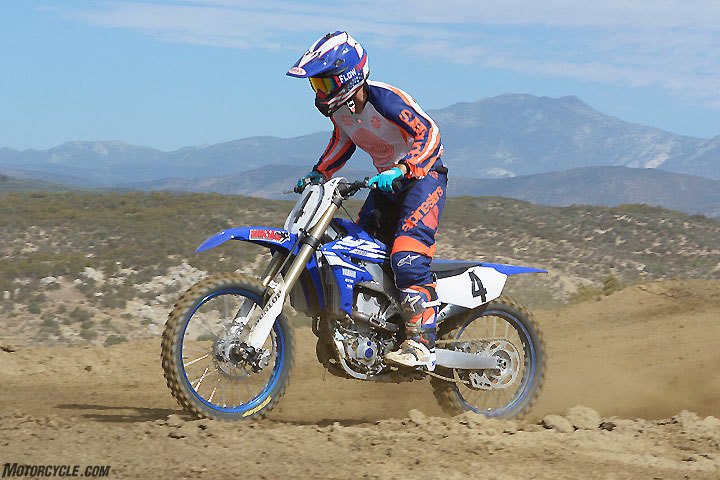 The latest generation of Yamaha’s KYB SSS fork and shock scored the highest in our suspension performance category. The Yamaha boingers deliver excellent sensitivity and stand up well to hard landings. The latest generation of Yamaha’s KYB SSS fork and shock scored the highest in our suspension performance category. The Yamaha boingers deliver excellent sensitivity and stand up well to hard landings.As part of its 2018 redesign, the YZ450F got a new version of the KYB SSS fork. The 48mm legs feature revised specs and settings to work with the Yamaha’s new bilateral beam chassis. The cylinder and piston size have been increased from 24mm to 25mm, and Yamaha replaced the coil-spring mid-speed valve spring design with a leaf spring. The pressure piston shape has also been changed, and it sports additional holes to help pass oil more efficiently. Out back, the YZ450F’s KYB piggyback shock body sub-tank capacity has been increased 30cc, and oil flow has been increased in an effort to offer more even and controlled damping. The shock spring is made of thinner material, which also helps reduce the spring weight. The spring rate is also 58 Newton/mm compared to the 56 Newton/mm spring found on the 2017. Although not unanimously selected by our test crew, the Yamaha handily topped the suspension performance category. Most appreciated the Yamaha’s suspenders right out of the box. “Definitely the best suspension out of any bike here,” Abbatoye said. “I automatically felt like I could race it right out of the truck. There pretty much isn’t anything that it can’t handle. Initial feel is great, and it has really good bottoming resistance. It was the only bike here that I felt like I could race with the stock suspension.” Smith agreed. “By far the best in the class,” he said. “To me it felt like you could feel the tires rolling across the ground, just hooked up the whole time. No harshness at all, just perfectly smooth, connected action.” Still, the KTM 450 SX-F with its WP AER48 fork and WP shock performed almost as well as the Yamaha, soaking up small bumps and big hits with equal competence. The new piston and air seals seem to eliminate any initial harshness that might have plagued the 2017 model. KTM’s relatively simple changes yielded improved overall suspension performance in this 2018 450cc motocross shootout. 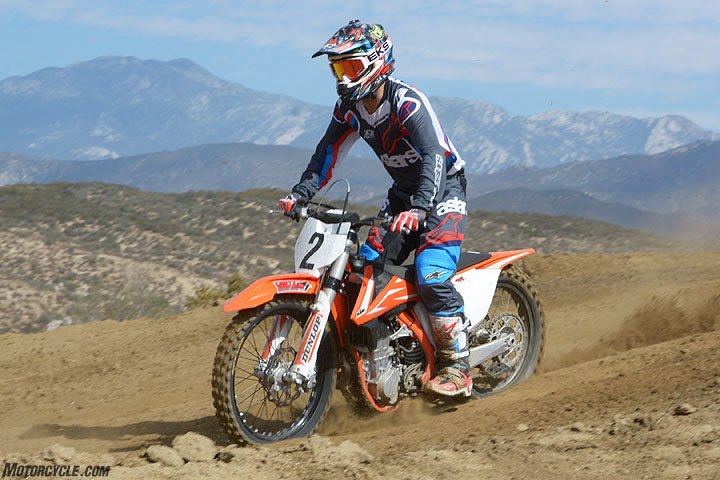 Don’t let the image fool you. The KTM 450 SX-F’s WP AER 48 air fork and WP rear shock can handle huge hits with ease, and they’re also easily dialed-in for small bump sensitivity. Ditto for the Husqvarna FC 450. Don’t let the image fool you. The KTM 450 SX-F’s WP AER 48 air fork and WP rear shock can handle huge hits with ease, and they’re also easily dialed-in for small bump sensitivity. Ditto for the Husqvarna FC 450.“In fact, this was the only bike I didn’t make changes to,” Stover said of the 450 SX-F.” It feels really planted, and it handles all the rough stuff the same. It doesn’t want to deflect on the big stuff, and it doesn’t feel harsh in the chop. I really like it. The KTM’s suspension feels better than the Husqvarna to me.” Abbatoye, however, found the KTM suspension to be a little on the soft side at first. “We stiffened it up, and it really worked well,” Abbatoye said. “I felt confident everywhere on the track.” Smith, however, wasn’t as impressed. “Through the beginning of the stroke, the KTM is plush and supple,” he said. “But into the mid-valve and the bottom of the stroke it felt a little harsh to me.” Of course, since they are basically identical to the KTM’s, the Husqvarna FC 450’s fork and shock also finish close to the KTM on the track. “When I first got on it, it was way too stiff for me, and it wasn’t riding balanced,” Abbatoye said. “Once we stiffened things up, it was night-and-day different. It soaks up super-choppy stuff really well.” Smith agreed, saying, “The rear suspension is really good. It tracks well and holds up in all the braking bumps and hard hits. The fork initially felt a little jarring, but slowing down the rebound tended to help out. Other than that, they have nice action. They don’t get twitchy or do anything funny.” 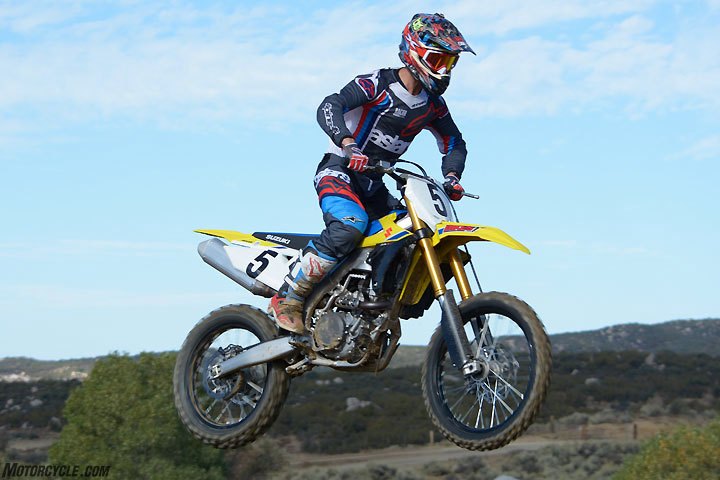 Suzuki’s decision to abandon its air fork in favor of a Showa coil-spring fork was a good one. Out back, however, its BFRC shock absorber could use more refinement. Suzuki’s decision to abandon its air fork in favor of a Showa coil-spring fork was a good one. Out back, however, its BFRC shock absorber could use more refinement.Once again a pleasant surprise in our 2018 450cc motocross shootout, the 2018 Suzuki RM-Z450’s new 49mm coil-spring fork and BFRC shock are a huge improvement over the 2017 model. “They have the new shock where the compression is one adjuster rather than the high-speed and the low-speed,” Smith said. “It really works well. One compression adjuster and one rebound adjuster, and it works. It doesn’t have any clickers. I went out ¼-turn, and it gave me exactly what I wanted. It’s supple yet soaks up big hits well. You won’t feel small chatter bumps, and it also doesn’t give you that clanking feeling. But Abbatoye felt that the BFRC shock, which features separate external damping circuits intended to improve shock sensitivity and response, still needs more work to match the performance of the Yamaha and the European bikes. “The new fork is 100 times better than the old one, but the shock could use some work,” Abbatoye said. “I got a little bit of kicking here or there. When you have a bike that is really dialed-in, you can relax more, but I always felt like I had to pay more attention on the Suzuki than on other bikes.” Another surprise was that, although most of our test riders claimed to like the CRF450R suspension, it didn’t finish as high in the 2018 450cc motocross shootout suspension performance standings as we thought it would. Honda’s decision to alter the CRF’s valving and go with stiffer valve springs in an effort to get the suspension to stand up a little more in choppy terrain drew mixed reviews from our test crew. “When I first got on it, it was way too stiff for me, and it wasn’t riding balanced,” Abbatoye said. “Once we stiffened things up, it was night-and-day different. It soaks up super-choppy stuff well, but I’m a lighter guy, and I feel like the 2017 springs and valving worked better for me.” Smith agreed, stating “I don’t know why they added heavier fork springs; for me it didn’t seem to help.” Even the 175-lb. Stover had to go softer up front to find suitable settings for the Honda. “The rear was fine, but for my riding style I want it to squat a little more, so I softened up the high speed a quarter turn. Up front, I still got a little more feedback into the bars than I wanted on the Honda.” The Kawasaki KX450F also drew a mix of comments from our crew. Abbatoye said that the KX’s Showa TAC air fork danced all over the place on the Cahuilla Creek track. 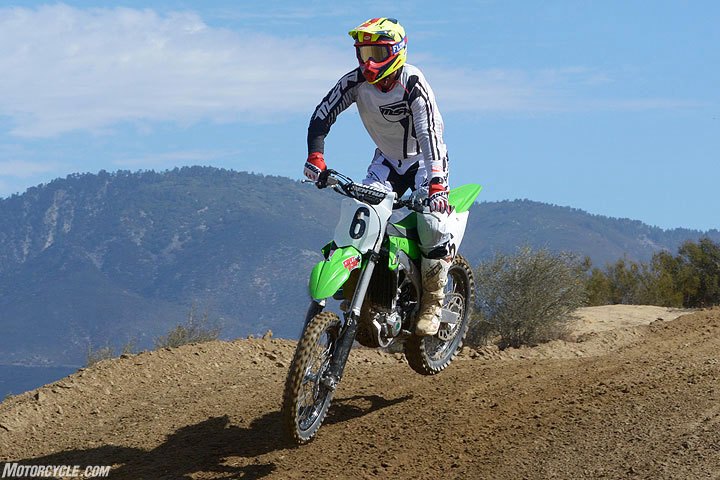 The Kawasaki KX450F’s Showa air fork and Uni-Trak rear suspension are competent but lack the plush feel of other bikes in the class. The Kawasaki KX450F’s Showa air fork and Uni-Trak rear suspension are competent but lack the plush feel of other bikes in the class.“We made some adjustments, which helped, but I feel like they need a lot of work to get right,” he said. “The rear end is okay, but I was so worried about the forks that I couldn’t concentrate on what the rear end was doing. I really had to concentrate to maintain a fast pace.” Stover also had issues with the Kawasaki’s front suspension action. “As soon as you start hitting the rough stuff, it feels like the fork is packing,” he said. “We softened up the front and took a little bit of air out. That helps, but it’s still not as good as some of the others. You really notice it in braking bumps. The rear feels pretty good, though. It has good bottoming resistance, but it stays nice and plush.” Smith, however, complimented the Kawasaki’s suspension. “It ate up the small stuff on the track like the high-speed chop — it was probably the best of the group at that — and it still sucked up the big hits well,” Smith said. “I think I was the only one who got it working well.” 2018 450cc Motocross Shootout Suspension Performance Results 1. Yamaha YZ450F 2. KTM 450 SX-F 3. Husqvarna FC 450 4. Suzuki RM-Z450 5. Honda CRF450R 6. Kawasaki KX450F Chassis Performance The Yamaha surprised us by taking top honors in the handling category as well. Its bilateral beam aluminum chassis retains a lot of the character of the 2017 chassis despite featuring straighter and flatter spars in the airbox area to give it a slimmer profile, and its tension pipes are much longer than on the 2017 model to help the chassis flex better than the 2017. 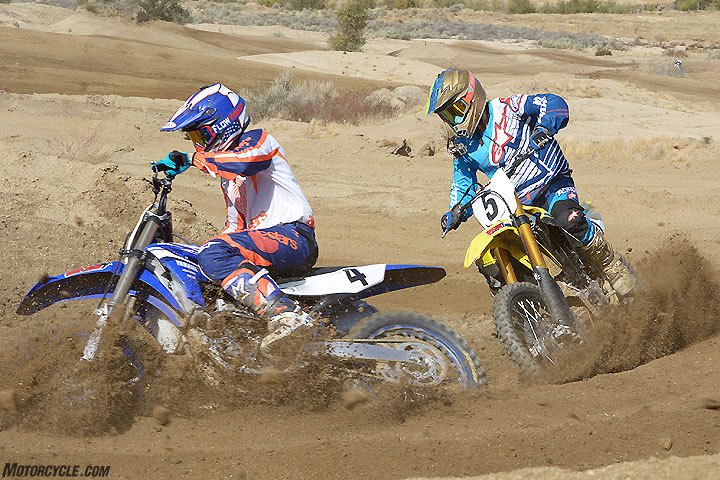 Both the Yamaha YZ450F and the Suzuki RM-Z450 are exceptional at carving corners. Both the Yamaha YZ450F and the Suzuki RM-Z450 are exceptional at carving corners.Our biggest complaint with the 2017 was that it tended to want to stand up in ruts and tight corners. The new chassis goes a long way toward fixing that by issue, as the steering pipe has been moved 6mm forward while the triple-clamp offset is increased from 22mm to 25mm and trail is increased 3mm to 121mm. Still, the Yamaha is one of the heaviest bikes in the class, checking in at 248 lbs. with its 1.6-gallon fuel tank topped. It places 119.5 lbs. on its front wheel and 128.5 lbs. on its rear wheel for a 42%/58% front/rear weight bias. But the weight didn’t seem to hurt the YZ450F on the track. The classic Yamaha stability is still a main trait of the new chassis, but the 2018 YZ450F also carves corners a lot better than the 2017 did, and that put it over the top in our scoring. “I was really surprised at how good the Yamaha felt,” Abbatoye said. “To me it’s the most stable bike out there. Some people said that it still likes to push wide, but I feel like it is a lot better in the corners than the 2017 model. It corners really well. It doesn’t oversteer, and it doesn’t push to the outside.” Stover was even more glowing in his assessment. “I think they fixed it,” he said of the Yamaha’s newfound cornering capability. “It really wants to dive into corners. Last year there was the issue of it not wanting to stay hunkered down. It’s like they took a play out of the Suzuki’s playbook for turning. At high speed it is a little more finicky than some of the other bikes in the class, but I wouldn’t say it’s unstable.” The lightest bike in the class, the KTM 450 SX-F spreads its feathery 234.3 lbs. along a 58.3-inch wheelbase, placing 112.4 lbs. on the front wheel and 121.9 lbs. on the rear. Its WP-designed chassis is made of 25CrMo4 chrome-moly steel — the European spec equivalent of what is known as 4130 chrome-moly in the USA, making the KTM and the Husqvarna the remaining holdouts using steel frame construction in the 450cc motocross class. Conventional chassis wisdom is that steel chassis still offer better feel and better bump absorption than aluminum, a notion to which Abbatoye subscribes. “The KTM feels pretty good,” he said. “It has that steel frame, so it has a more compliant, forgiving feel than any of the aluminum chassis. I like that feel. It turns really well, inside or outside, and it’s really stable. It sticks really well, and it tracks really well.” 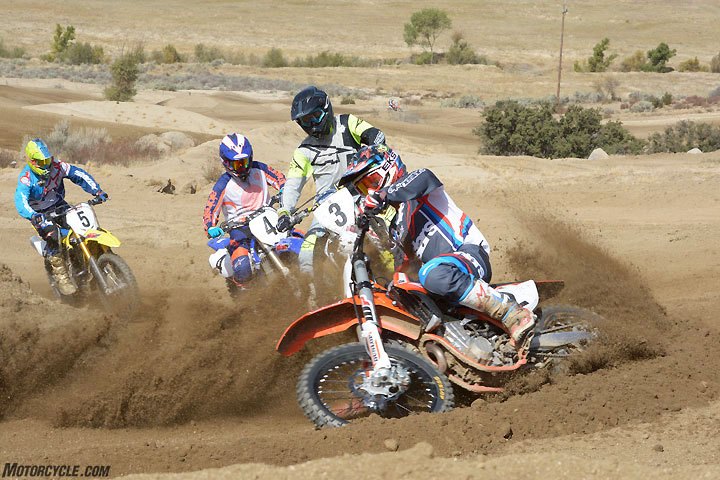 The KTM can carve a tight line with the best of them, but it likes railing outside berms where you can maintain momentum and keep the 450 SX-F’s engine spinnng up in the rev range. The KTM can carve a tight line with the best of them, but it likes railing outside berms where you can maintain momentum and keep the 450 SX-F’s engine spinnng up in the rev range.Stover noted that the KTM 450 SX-F chassis feels the same as the Husky. “It feels really good. You just don’t get any harsh feedback from the chop. The frame does such a good job of absorbing everything without transferring it to the rider. It turns really well. It’s right near the top of the class. It likes tighter corners better than sweepers, but it works well at both.” You’d think that if the KTM felt that good, then it follows that the Husqvarna would as well, and yet the battle for third in our Chassis Performance category came down to the Suzuki RM-Z450 and the Honda CRF450R, with the Suzuki just edging the Honda in the opinion of our crew. Suzuki engineers clearly put a lot into improving the RM-Z’s twin-spar aluminum frame, making it slimmer and shaving 1.32 lbs. weight from the package. Even so, the Suzuki checks in at 250.3 lbs. the heaviest bike in the class — and that’s without an electric starting system, which would add even more weight. But, Suzuki has its steering geometry so dialed-in that you’d never know the RM-Z weighs as much as it does on the track. When it comes to cornering, the RM-Z450 has been hard to beat for the past few years, and that much remains unchanged. Even better, the new chassis is more stable than past versions. “The Suzuki’s straight-line stability is actually surprising,” Smith said. “You can feel how well it turns, but when you’re going through acceleration bumps on the track, it tracks straight. You can dive it into a corner quickly as well. It can change direction really quickly when you want it to. It is very confidence-inspiring.” Stover added that the Suzuki ranks well in the handling department because it’s very precise. “It wants to go where you want it to go,” Stover said. “It doesn’t oversteer or understeer. You can hit the same lines over and over again. And it’s a Suzuki, so it corners like a dream, but in a straight line it’s very stable. I didn’t hit anything that made it go sideways or headshake. No complaints at all.” 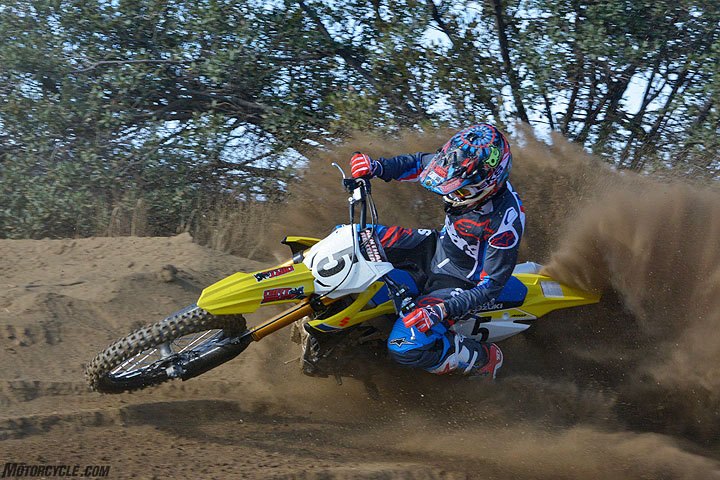 The RM-Z450’s slim chassis still retains Suzuki’s classic cornering prowess. It goes wherever you point it. The RM-Z450’s slim chassis still retains Suzuki’s classic cornering prowess. It goes wherever you point it.However, Abbatoye noted that while it corners great, the Suzuki chassis still imparts a stiff ride compared to some of the other bikes in the class. “It’s better,” he said. “But it still has a rigid feel.” So, how is that the Honda slid so far backward despite not being changed by a single degree or millimeter? Remember that suspension tweak Honda made to give the Honda a bit more resistance in the bumps? Suspension performance is a vital piece of the puzzle when it comes to handling. “It turns really well, and Hondas have never had an issue with that, but in a couple corners it tended to oversteer,” Abbatoye said. “I think that had to do with it having a rear spring that was too stiff. It doesn’t shake or do anything weird, though.” Smith was also critical of the Honda’s handling. “Stink bug feel,” he said. “The front end of the chassis is really rigid, too, and it was giving me too much feedback. I think the frame could stand to flex a little more. It’s either that or maybe the triple clamps.” 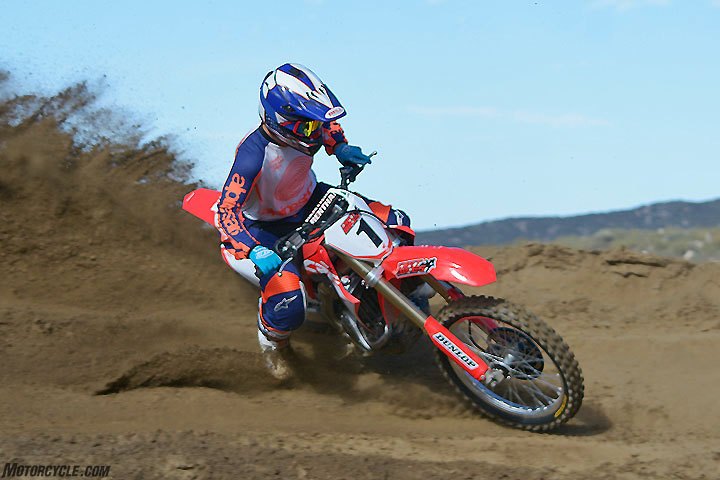 The 2018 CRF450R’s handling is still great, but the suspension changes that Honda made to get the CRF to stand up better in the bumps take a little edge off the sharp handling that we experienced with the 2017 model. The 2018 CRF450R’s handling is still great, but the suspension changes that Honda made to get the CRF to stand up better in the bumps take a little edge off the sharp handling that we experienced with the 2017 model.Stover was less critical of the CRF’s handling. “The Honda has very good handling,” Stover said. “It likes going inside or railing corners, and it feels really light in the air. When you’re on the gas or braking, it’s good. If you’re on the gas and chop the throttle, it tends to unload and get light on the front end.” The Kawasaki KX450F rated the lowest in the category, but it’s not as if the KX handles poorly. At 240.1 lbs. full of fuel, it isn’t the heaviest bike in the class, but it is the most nervous. The majority of our testers complained that the green machine’s straight-line stability wasn’t as solid as the other bikes in the shootout. “After riding the other bikes, the KX took some getting used to,” Abbatoye said. “It shook its head for me. It doesn’t corner badly, but it likes outside corners rather than inside corners. Other bikes turn tighter. Straight-line stability isn’t very good.” Stover noted that the Kawasaki can handle tight corners if the rider steers it with the throttle. “It will follow the front in real tight corners if you are hard on the brakes, but once you get back on the throttle, you really have to get on it to get Kawasaki to finish a tight line,” Stover said. “It feels a little heavy in the air, but it is really predictable. It has a slightly heavier feeling than the other bikes.” Smith agreed, noting that the Kawi’s steering effort is heavier and its steering response is slower than the rest of the class. “It still feels like it tracks well through corners, but it just takes more steering effort to get it to switch lines,” he said. 2018 450cc Motocross Shootout Chassis Performance Results 1. Yamaha YZ450F 2. KTM 450 SX-F 3. Suzuki RM-Z450 4. Honda CRF450R 5. Husqvarna FC 450 6. Kawasaki KX450F Braking Performance Every one of the machines in our 2018 450cc shootout has very good binders, with all of them boasting front rotors of at least 260mm in diameter with twin-piston calipers to bring the proceedings to a halt quickly as the rider enters a corner or approaches an obstacle. Three of the Japanese machines, the Kawasaki KX450F, the Suzuki RM-Z450 and the Yamaha YZ450F all boast even larger 270mm rotors up front; Suzuki finally made the switch to 270mm from its 250mm rotor for 2018. Out back, braking is handled by 240mm rotors on the Japanese machines and 220mm rotors on the KTM 450 SX-F and the Husqvarna FC 450. 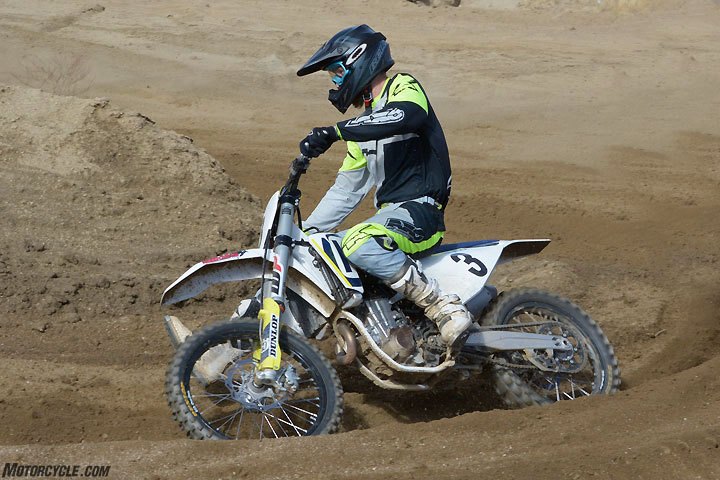 It doesn’t matter which European bike you’re riding, the Brembo brakes they wear are the best binders on any dirtbike available today. It doesn’t matter which European bike you’re riding, the Brembo brakes they wear are the best binders on any dirtbike available today.The KTM and the Husqvarna are also fitted with Brembo master cylinders and calipers, and once again our test crew was unanimous that the Brembos rule when it comes to ultimate stopping performance in the 450cc class. In the only first-place tie in any of our categories, the 450 SX-F and the FC 450 handily beat the Japanese when it comes to stopping power. The Brembos may have a slightly less linear feel than the others, but it takes very little time to master them, and once you do you can stop on a time in just about any type of dirt. “The Husqvarna and the KTM stand out to me,” Abbatoye said. “Some people might find the Brembos to be super touchy, but they work so well. Get used to them, and you won’t stop quicker on anything else!” Stover agreed, noting that the Brembo units on the KTM and Husqvarna are the best in class. “Nice and strong. Good power. Excellent modulation.” Second place was very closely contested among the Yamaha YZ450F, Suzuki RM-Z450 and the Honda CRF450R, with the Yamaha edging out the other two in overall braking power and feel. Smith summed it up best when he said, “The Yamaha front brake lever has a positive, soft feel compared to the rest, but you can feel where you are in the braking power much better, so you can play where you want to with the power. The YZ’s brakes aren’t as strong as the KTM’s and Husky’s, but they feel really good.” 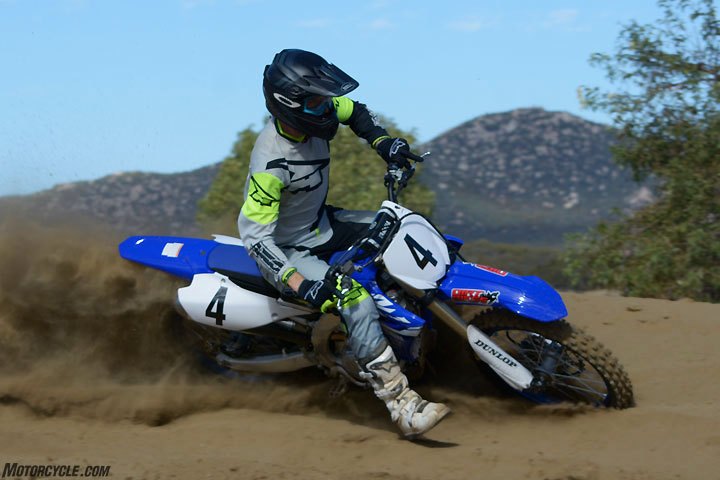 The Yamaha YZ450F sports a 270mm front disc and a 240mm rear disc. Stopping power is not quite up to par with the KTM or the Husky, but it’s the best of the Japanese bikes. The Yamaha YZ450F sports a 270mm front disc and a 240mm rear disc. Stopping power is not quite up to par with the KTM or the Husky, but it’s the best of the Japanese bikes.Stover felt that the Yamaha’s brakes were a little too progressive for his liking, but he felt that they still delivered good stopping power. Abbatoye also noted that the Yamaha’s brakes work well but aren’t on par with the KTM and Husky. 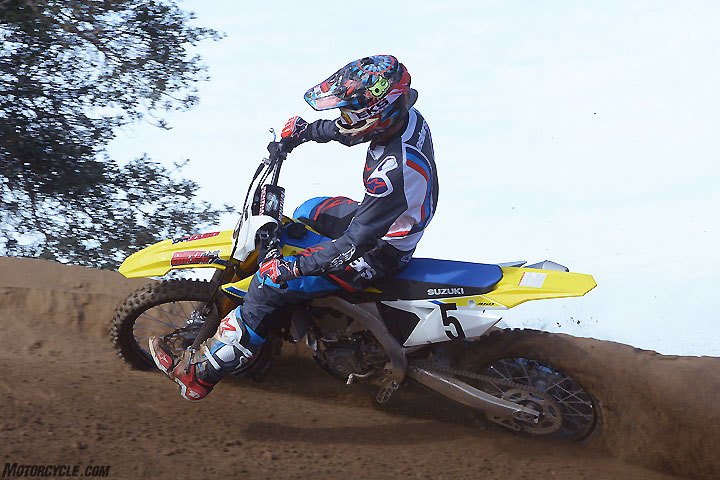 Suzuki upgraded to a 270mm front brake on the 2018 RM-Z450, and its stopping power and feel are improved over the 2017 model. Suzuki upgraded to a 270mm front brake on the 2018 RM-Z450, and its stopping power and feel are improved over the 2017 model.Suzuki’s switch from a 250mm front rotor to a 270mm front rotor was worthwhile, as the RM-Z450 came in right behind the Yamaha in our Braking Performance category scores. “The Suzuki stops well,” Abbatoye said. “The brakes are easy to modulate, but they don’t even come close to the Brembos on the KTM and Husqvarna when it comes to power.” While Smith complained that the RM-Z’s front brake was a little on the touchy side, Stover said, “The Suzuki’s brakes are good without being too powerful. Not the strongest in the class but not the weakest. They’re just not really an issue.” 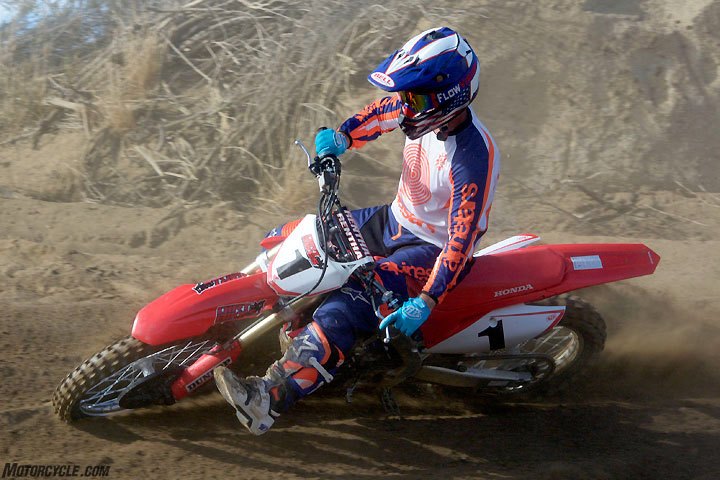 The Honda CRF450R’s front brake lever pull was found to be on the stiff side compared to other bikes in the class. The Honda CRF450R’s front brake lever pull was found to be on the stiff side compared to other bikes in the class.The Honda CRF450R’s stopping performance was on par with the Suzuki RM-Z450 at Cahuilla Creek. Abbatoye pronounced them, “Good as always,” but Smith and Stover both nitpicked the Honda. Smith felt that the front brake pull on the CRF450R was on the stiff side. “The Honda front brake could stand to be a little more aggressive,” Stover noted. “I don’t want to say it’s spongy, but it gave just a little more than I would prefer. The rear brake works well. It’s strong and has a good feel.” While no one had any major complaints with the Kawasaki KX450F’s brakes, the group felt that they simply didn’t feel as strong as the binders on the other machines in the comparison. Smith noted that the KX’s stopping power was adequate while Abbatoye said that they exhibited “decent power and feel.” Stover was less impressed. 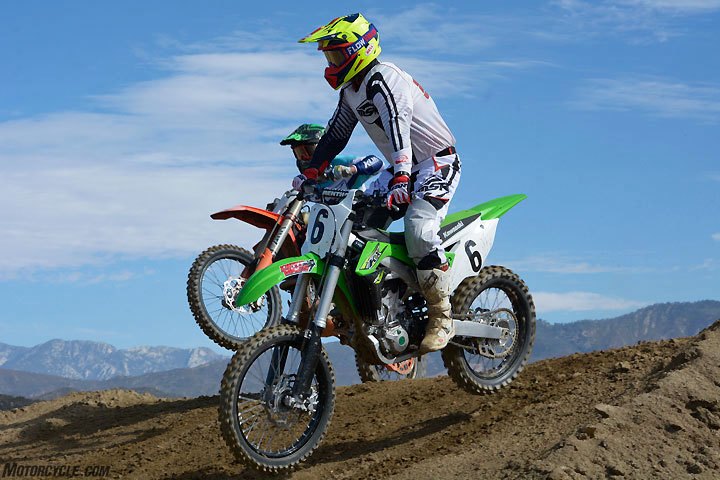 The Kawasaki’s brakes weren’t a favorite among our test crew. The Kawasaki’s brakes weren’t a favorite among our test crew.“The KX’s brakes leave something to be desired,” Stover said. “You really have to get into them in order to get them to lock up.” 2018 450cc Motocross Shootout Braking Performance Results 1. (TIE) Husqvarna FC 450/KTM 450 SX-F 2. Yamaha YZ450F 3. Suzuki RM-Z450 4. Honda CRF450R 5. Kawasaki KX450F Ergonomics The fastest motorcycle on the track isn’t going to be much fun if the rider can’t get comfortable on it. Most of these 450cc machines offer some form of ergonomic tailoring via adjustable handlebar clamps and/or adjustable footpegs to help their chassis fit a wider variety of body shapes and sizes. It’s our opinion, however, that comfort can be assessed by chassis layout, seat contour and bar height and shape more so than where the bar is positioned on the triple clamp. 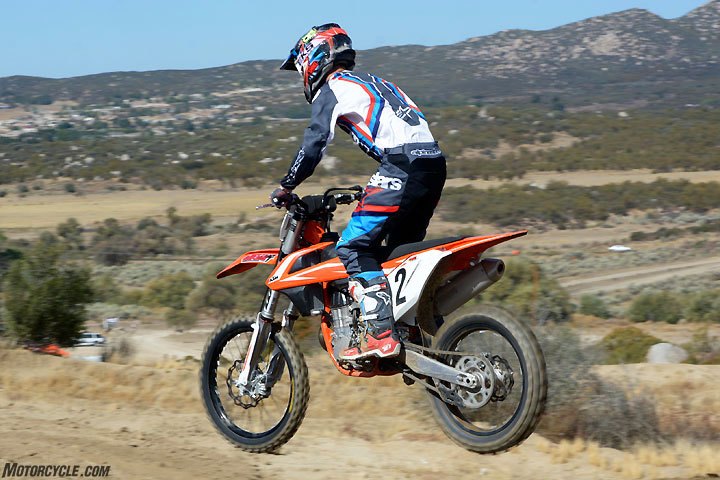 The 2018 KTM 450SX-F ranked highest in our ergonomic category. The KTM has a small, slim and very light feel. The 2018 KTM 450SX-F ranked highest in our ergonomic category. The KTM has a small, slim and very light feel.For 2018, our test crew deemed the KTM 450 SX-F as the most comfortable bike on the track. The KTM’s super-compliant steel chassis, razor-thin feel through the middle, and smallish overall dimensions were a big hit during our shootout. “The KTM is probably one of the smallest-feeling bikes ever, and the lightest for sure,” Abbatoye said. “Everything feels pretty comfortable, but it has hard seat. Actually, they all do.” Stover added that the KTM’s layout is “Nice and flat, really easy to move around on. It doesn’t feel like the bike is trying to hold you in one place.” Even while complaining about it, Smith had to admit that the KTM is the best of the bunch when it comes to ergos. “High on the tank, where the shroud mounts, it feels like your knee can kind of get caught in there,” Smith said. “The seat is stiff, but the handlebars felt neutral. Seat to pegs was a good feeling, too, and it’s really thin in the knee area.” 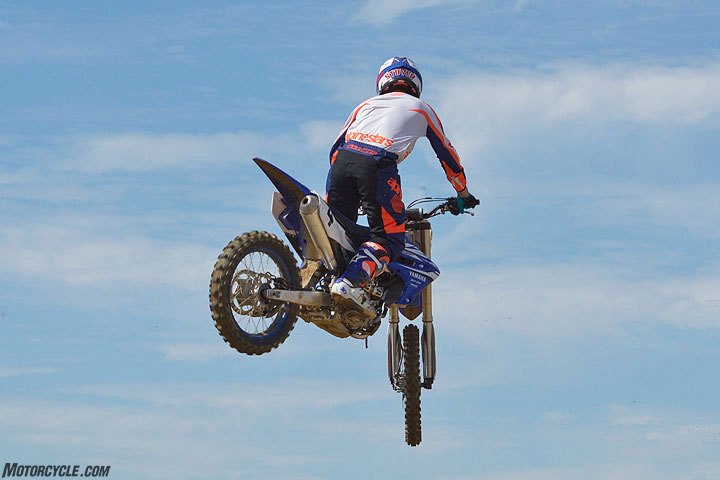 After feeling bulky in 2017, the YZ450F seriously gained favor among our test crew. Its new bilateral beam chassis is slimmer through the middle and in the shroud area, which makes it easier to move around in the cockpit. After feeling bulky in 2017, the YZ450F seriously gained favor among our test crew. Its new bilateral beam chassis is slimmer through the middle and in the shroud area, which makes it easier to move around in the cockpit.Surprise, surprise, the Yamaha YZ450F came in second in this category. Last year the Yamaha was roundly criticized for its wide and bulky feel through the mid-section and tank-shroud areas, but the Yamaha’s new chassis is much slimmer and features a more compact airbox and slimmer shrouds for a more tucked-in feel. The difference was noticeable. “It feels a lot slimmer,” Abbatoye said. “They got rid of the bulky shrouds. It doesn’t feel as small as the Honda or the KTM. It’s closer to the Suzuki in feel. It felt perfect to me. You can really tell that Yamaha put a lot into it, and they did a good job.” Stover felt that while the YZ still feels a tad wider up front than its competition, “It’s not nearly as bad as it was last year. It is a lot easier to hang onto than it was last year.” Smith, too, praised the Yamaha’s ergonomic improvement everywhere except for its handlebar. “The new bodywork and everything make it feel thinner and more nimble all-around,” Smith said. “You feel like you’re in the bike and have good control, but the handlebars are high. I didn’t like the bars.” 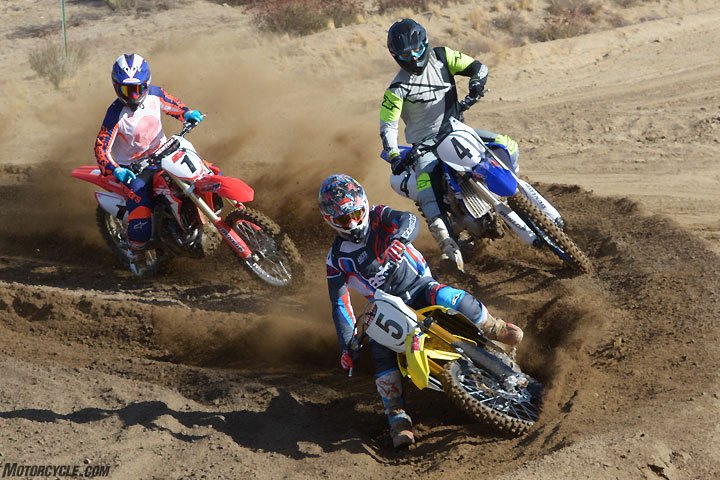 The Suzuki RM-Z450 is one of the smallest feeling bikes in the class. It’s also one of the lightest feeling even though it is the heaviest bike in the group. The Suzuki RM-Z450 is one of the smallest feeling bikes in the class. It’s also one of the lightest feeling even though it is the heaviest bike in the group.Thanks to its new, slimmer chassis, the Suzuki RM-Z450 once again reached the podium in this category. There wasn’t a whole lot to complain about in terms of the Suzuki’s cockpit layout last year, but now it’s even thinner and smaller-feeling than before, which definitely helps to hide its heaviest-in-class 250.3-lb. weight on the track. “The Suzuki feels really good, sitting or standing,” Abbatoye said. “It doesn’t quite feel as small as the Honda or KTM, but the seating position, bar position and peg position are all pretty much right on with the RM-Z.” Stover agreed, saying, “The Suzuki feels very thin. The seat is a tad stiff, but overall the RM-Z feels really good, like a race machine should. Everything feels like it’s where it should be.” Smith mentioned that the RM-Z’s riding layout felt a little cramped. “But I actually liked it,” he said. “That smaller feel, I liked it.” 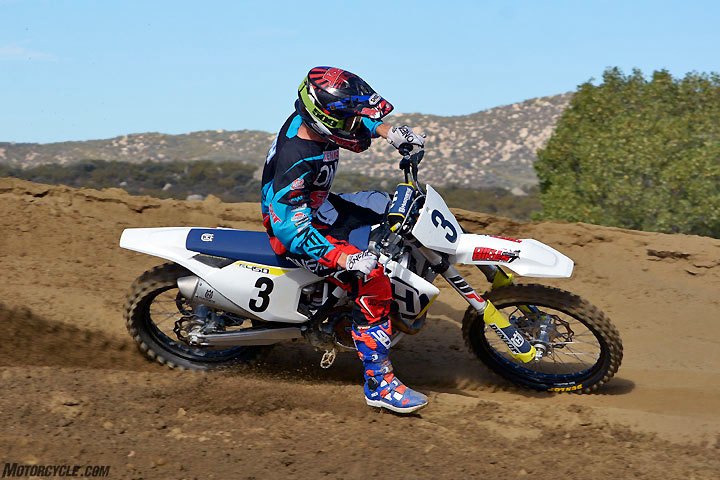 The Husqvarna FC 450 was criticized for having an odd, chopper-like feel and a stiff, square-edged seat. The Husqvarna FC 450 was criticized for having an odd, chopper-like feel and a stiff, square-edged seat.The Husqvarna FC 450 was also generally praised by our crew. Although the Husky shares the same main frame as its KTM sister, the FC 450’s unique, carbon-fiber subframe and full-coverage side panels add width to an otherwise slim and smooth ergonomic package. “The way everything is contoured on the bike is really smooth, so you don’t get hung up,” Smith said. “The way you sit on the bike, and the height and shape of the handlebars, were perfect for me.” Stover also liked the FC 450 for the most part. “The bike feels good, and the bars feel good,” he said. “The seat feels a little square to me, like you’re getting a little too much rubbing on the outside edges of the seat because it is wider than others. But the side paneling is smooth, and you really feel like you can grip it because it flares out as you move toward the back of the bike. It gives you a good feeling of control.” On the other hand, Abbatoye was a little weirded-out by the Husqvarna FC 450’s ergos. “It feels different,” Abbatoye said. “It’s more like the back end is too low where others feel really level. It’s a chopper-like feel. The bars are too high.” 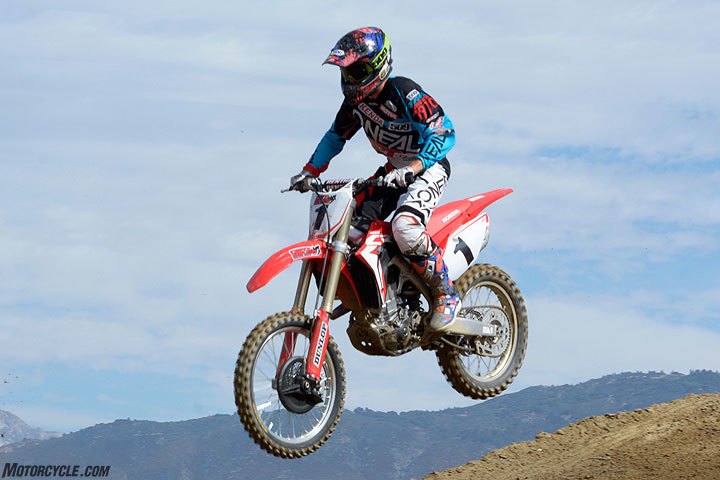 The Honda CRF450R’s ergonomics were mostly praised by our test crew, but some complained about Honda’s decision to retain a smallish 7/8-inch handlebar. The Honda CRF450R’s ergonomics were mostly praised by our test crew, but some complained about Honda’s decision to retain a smallish 7/8-inch handlebar.The Honda CRF450R also boasts a comfortable feel that is on the small side, according to our testers, but there were other issues that prevented it from claiming top honors in the ergonomic category. “The Honda’s cockpit is really comfortable,” Smith said. “It puts you right in the bike where you need to be. Its bodywork is also really smooth, so you don’t get caught on anything.” Stover also liked the Honda. “Very comfortable,” he said of the CRF450R. “It didn’t take any time to get used to the bike. I jumped on it and felt right at home. There’s nothing weird about it. I liked how flat the seat is, and the bars aren’t too high or too low. However, Abbatoye had an issue with the fact that the Honda still doesn’t come with a 1 1/8” handlebar. “No fat bars, and it needs them,” Abbatoye said. “Other than that, I didn’t have any issues. It was one of the smallest feeling bikes in the class. It feels light and small, but on paper it isn’t all that light.” 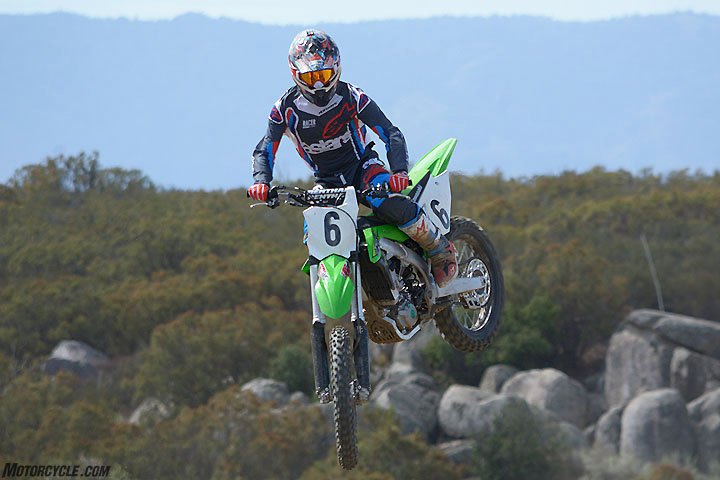 The Kawasaki KX450F has a long feel that some of our testers didn’t care for. It also lacks over-sized “fat bars,” which drew criticism. The Kawasaki KX450F has a long feel that some of our testers didn’t care for. It also lacks over-sized “fat bars,” which drew criticism.Abbatoye also marked down the Kawasaki for its lack of over-sized bars. “The Kawasaki feels long, and why doesn’t it come with fat bars?” he griped. “They change the feel of things and give a bike a more solid feel. The Honda didn’t have them either. They should both have them. And the bars feel as though they’re too far behind the forks rather than on top of them.” Smith also noted that the KX450F is slim but has a long feel. “It feels like you sit on top of the bike unlike the rest of them where you sit in the bike,” he said. “I think the ergonomic triangle feels pretty neutral, but the bike feels heavy overall. From the waist down it was fine, and at least you can adjust both the footpegs and the handlebars.” Stover echoed Smith’s conclusions. “The Kawi feels a little bigger than the other bikes, and it feels a little long,” Stover said. “It’s not as slim as the Suzuki or the Honda, but it isn’t as wide up front as the Yamaha. In the center, where you spend most of your time riding it, it feels a little wider than the other bikes.” 2018 450cc Motocross Shootout Ergonomics Results 1. KTM 450 SX-F 2. Yamaha YZ450F 3. Suzuki RM-Z450 4. Husqvarna FC 450 5. Honda CRF450R 6. Kawasaki KX450F The Final Verdict The reality is that you can hardly go wrong selecting any of these 450cc motocrossers for your next moto session. As we said from the beginning, none of these 2018 450cc motocross shootout is perfect, but some are simply at or near the top of the class because they are more refined than others. It should come as no surprise, then, that the 2018 Kawasaki KX450F slots into sixth place in our shootout for that very reason. 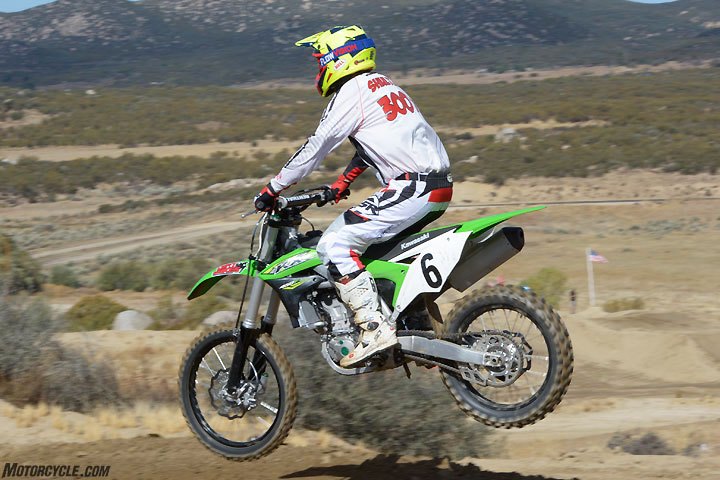 2018 Kawasaki KX450F – 6th Place, 78.3% 2018 Kawasaki KX450F – 6th Place, 78.3%An all-new KX450F is probably waiting in the wings for 2019, and if it isn’t then Kawasaki needs to get on the gas. While there are no major flaws in the KX450F’s current design, it simply doesn’t keep up with the competition in a class that has seen significant development over the past two years. The KX comes up short in terms of its overall power delivery, and that air fork has got to go. The Kawasaki still appears to have a lot of potential, but to extract it will require shopping the aftermarket. An $8849 MSRP makes it the least expensive 450 in this test, but in our opinion it may be worth the extra Benjamins to start with a newer or more dialed-in machine to attain berm-bashing nirvana. That said, if you have a really good Kawasaki dealer in your home town, and you like green machines, the KX450F could be the bike for you.  2018 Honda CRF450R – 5th Place, 83.1% 2018 Honda CRF450R – 5th Place, 83.1%We were surprised… no, shocked… to learn that when our comprehensive scorecard was filled out by all of our riders, the Honda CRF450R — our 2017 class champion — finished fifth in the 2018 450cc motocross shootout. Seeing the forest for the trees, however, the final tally shows that the Honda battled valiantly with the Suzuki and Husqvarna to finish within 1 percentage point for the final spot on the overall podium, and a few points here or there could have really swung the results the Honda’s way. The CRF still boasts the exciting power delivery that made it a winner last year, and its electric-start system as a standard feature endears it to us even more than the 2017 model, but there was also a slight price increase that does influence our objective scoring and penalizes the CRF450R by a few points right off the bat. On top of that, Honda’s decision to fiddle with the CRF’s damping and spring rates was, in our opinion, not a good one. The 2018 CRF may stand up better in braking bumps and other chop, but some of its fluid, supple feel has been lost in the process. Many of our testers also noted that finding the right sag adjustment is even more critical in getting the Honda suspension set up than on other bikes. It may just be the difference between our chosen test tracks from 2017 to 2018, or we may be in the minority viewpoint here, but that’s fine — we were when we selected the Honda as the winner of our 2017 450cc Motocross Shootout as well. The bottom line is that the points are the points, and while it is a bit surprising to see the Honda slip down the order this year, our takeaway is that it is still a podium contender and a great bike overall.  2018 Suzuki RM-Z450 – 4th Place, 83.7% 2018 Suzuki RM-Z450 – 4th Place, 83.7%We don’t know whether or not to be as surprised by the Suzuki’s fourth-place finish, because in redesigning the RM-Z450, Suzuki engineers addressed many of our complaints with the 2017 model and gave the bike what it needed to raise its level of competitiveness. All of the classic Suzuki positive traits are still there, but the 2018’s chassis is less reactive to harsh bumps, and its new suspension is worlds better than the previous model. Even so, there is still some more refinement work to be done on its shock absorber, and its engine could use even more punch even though the new power curve with its greater top-end thrust makes the RM-Z450 easier to ride fast than ever before. The RM-Z450 still lacks an electric start feature, and its DFI coupler tuning feature is archaic compared to every other model but the Kawasaki KX450F. Still, Suzuki managed all the 2018 RM-Z450 changes while keeping the MSRP under nine grand. That’s more impressive than the Suzuki’s final standing in our 2018 450cc motocross shootout might otherwise indicate. 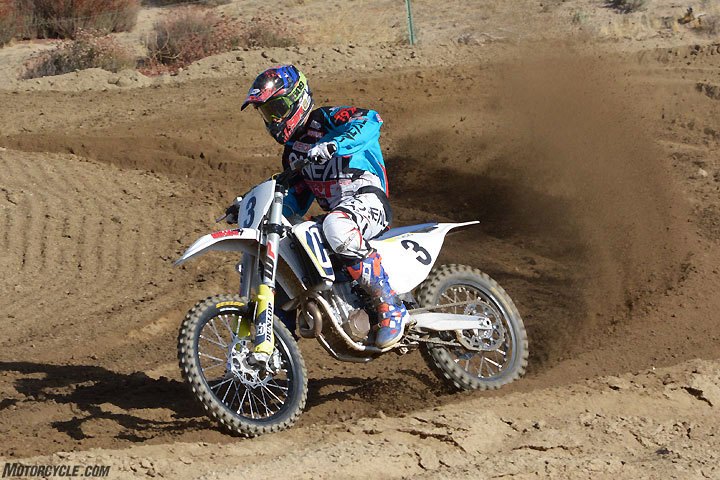 2018 Husqvarna FC 450 – 4th Place, 84.0% 2018 Husqvarna FC 450 – 4th Place, 84.0%That the Husqvarna FC 450 finished third in our 2018 450cc motocross shootout is easier to understand. Husqvarna only made minimal changes to the FC 450 for 2018, and it finished third in our 2017 shootout, a year in which the Honda CRF450R was the only all-new bike in the class. With two all-new designs from Suzuki and Yamaha hitting the stage in 2018, the competition was bound to be that much tougher for the Husky, and at $9699 it is the most expensive bike in the class. One thing that our Scorecard really helps with is to weed out bias and force our test riders to really compare the bikes by assigning point values in a lot more categories than we could talk about in our story. So even though the FC 450 may have felt less exciting than some of the other machines in the class, our testers couldn’t deny that the polished overall package performs really well. At the end of the day, its muted power feel and slightly odd ergos robbed it of the points it needed to stay match the KTM 450 SX-F even though the two machines share a lot in common. 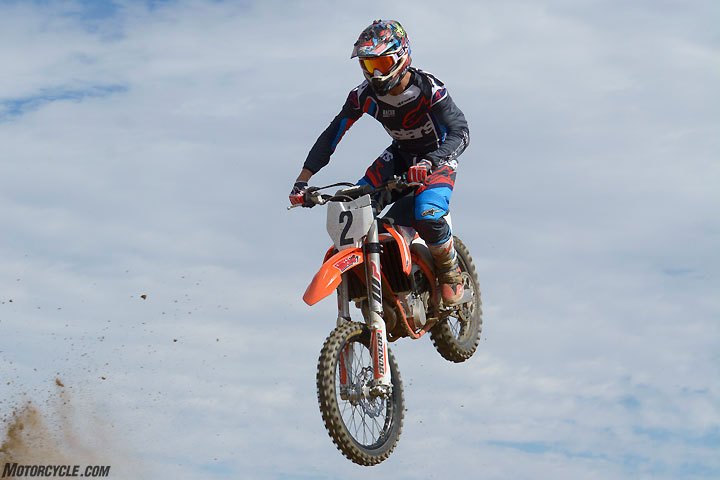 2018 KTM 450 SX-F – 2nd Place, 88.3% 2018 KTM 450 SX-F – 2nd Place, 88.3%We said last year that if KTM had supplied us with its standard production 450 SX-F rather than its pricey Factory Edition, it would have won our 450cc shootout, so we expected the KTM to be a real contender in our 2018 450cc motocross shootout despite the minimal revisions found in the 2018 model. The KTM is simply a badass 450cc motocross machine by virtue of being highly refined and possessing zero quirks or weird traits to hold it back. Its power delivery is forceful yet mirror smooth, and it handles like a dream. The small change that KTM made to the 450 SX-F’s fork is a larger step forward than we expected, and it only increases our faith that, indeed, someone can manufacture an air fork that matches the supple feel of a coil-spring fork. However, the added maintenance factor of the fork is still consideration, as is the KTM’s $9599 MSRP, the second highest in the class. Really, though, were it not for the invasion of the all-new model that won our shootout, the KTM would have emerged victorious. If that sounds like we’re making excuses for the 450 SX-F, forget it. Good riders will haul ass on this orange bomber, and KTM’s loyal legion of fans won’t care that it didn’t finish first. The 450 SX-F is one mean machine but in the nicest way possible. 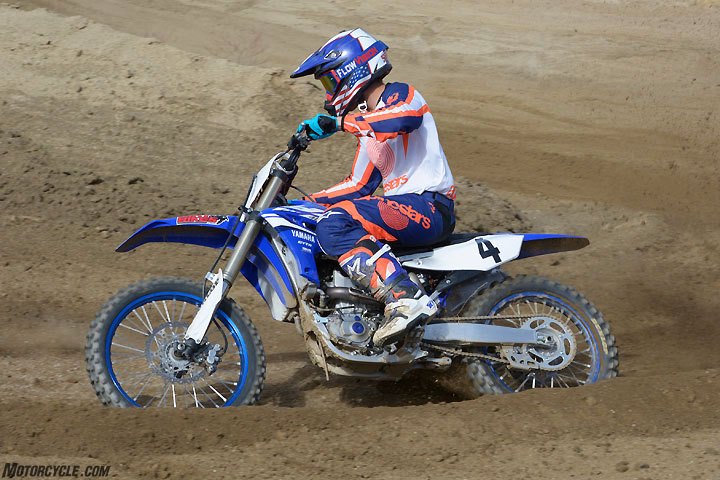 2018 Yamaha YZ450F – 1st Place, 90.1% 2018 Yamaha YZ450F – 1st Place, 90.1%That leaves the 2018 Yamaha YZ450F as the champion of our 2018 450cc motocross shootout. Where Honda basically reinvented the CRF450R’s character by making it more rowdy in 2017, Yamaha’s all-new redesign of the 2018 YZ450F actually took the blue bike’s unruliness down a notch to make it a better dirtbike. The YZ is still the brawny battlewagon that it always has been since the rearward-inclined engine design came online, but Yamaha has continued to evolve the beast without taking away what makes it so exciting in the first place: awesome engine performance. The YZ450F’s new chassis goes a long way toward ridding the bike of its bulky ergonomic feel, and it carves corners much better than the old chassis without sacrificing stability. Add Yamaha’s already excellent suspension performance, electric start and technology-stretching wireless tuning capability, and you have a motorcycle that pushes the envelope toward the next generation of motocross performance more than any other. The 2018 Yamaha YZ450F isn’t quite perfect, but it is the best 450cc motocrosser available in a dealer showroom today. 2018 450cc Motocross Shootout Scorecard Hover your mouse over the overall score for individual category ratings. Motorcycle Overall Overall Overall Honda CRF450R
FC 450
KX450F
450 SX-F
RM-Z450
YZ450F
 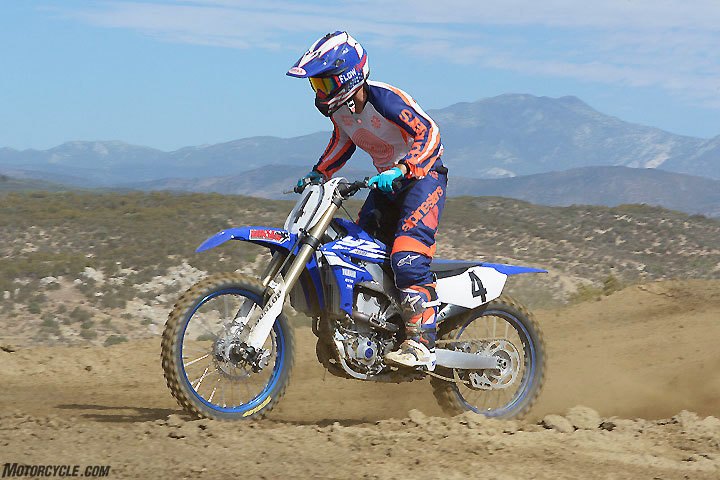 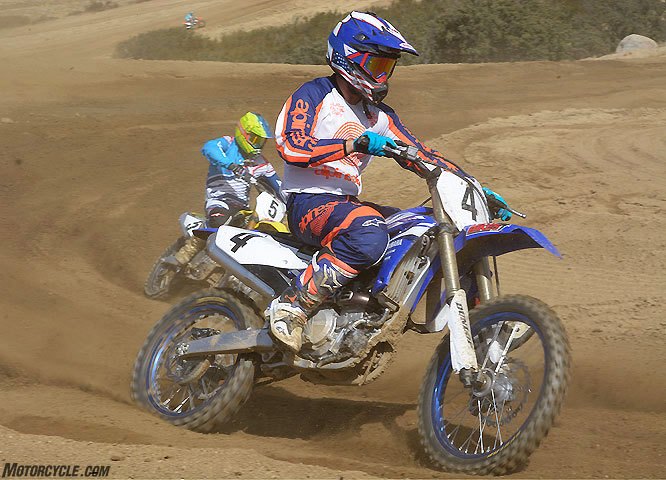 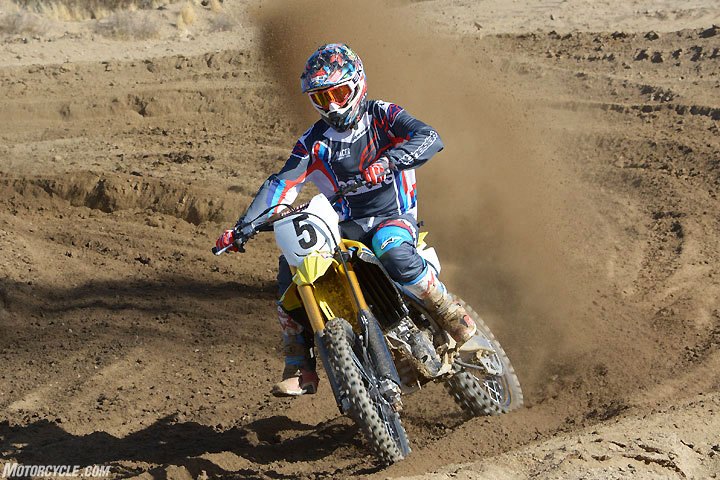 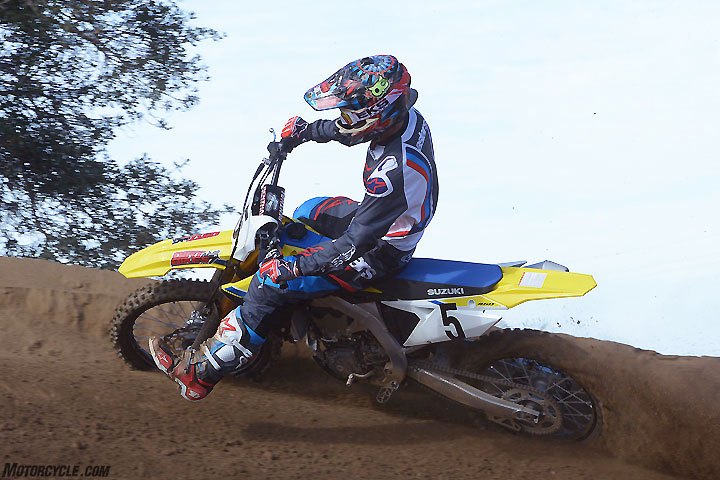 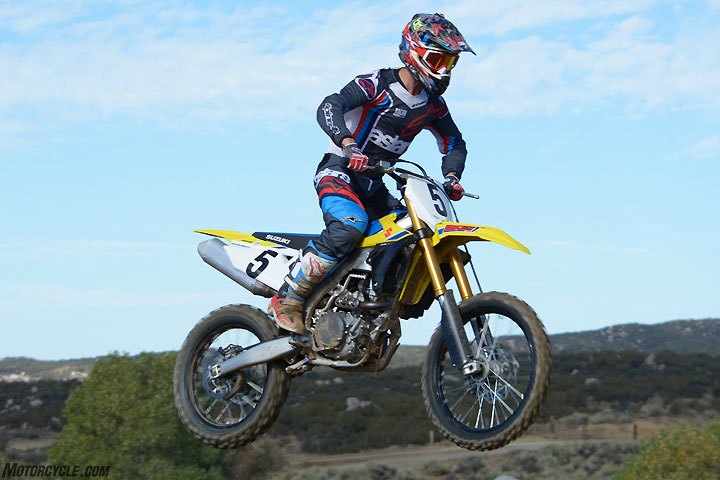 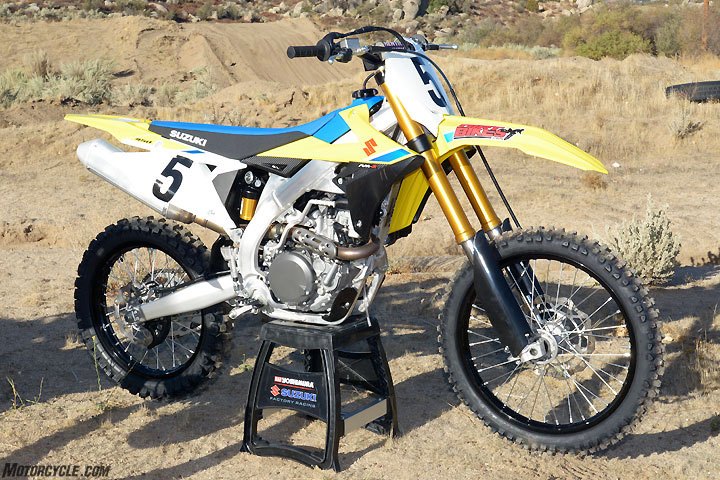 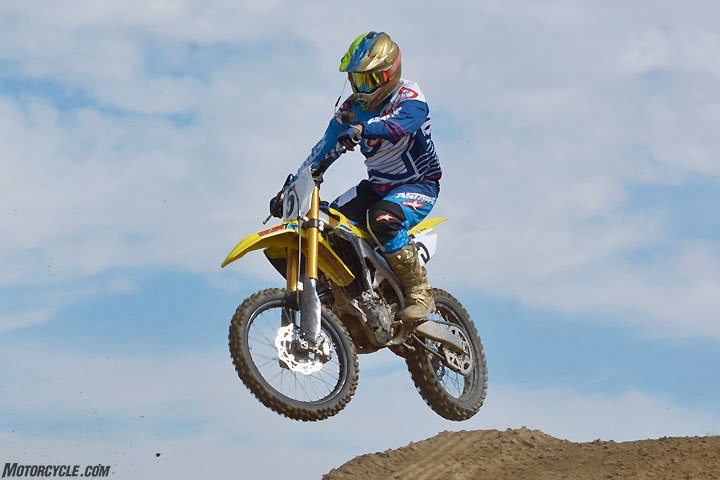 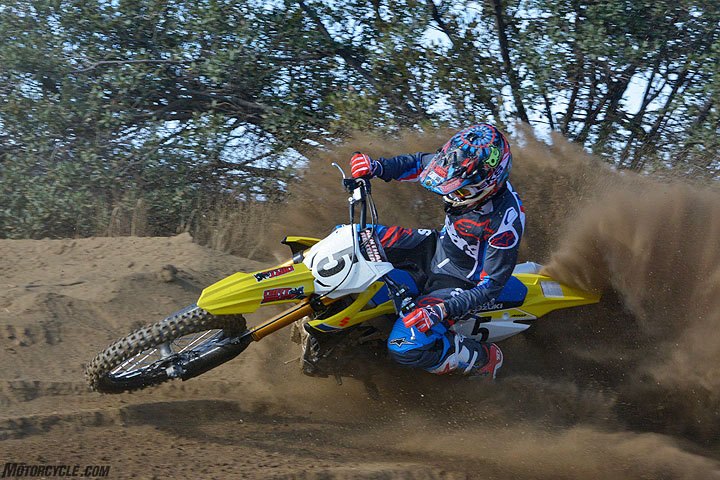  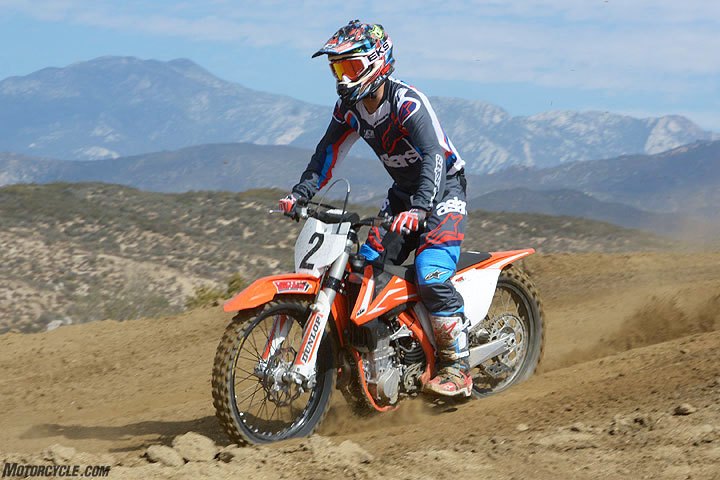 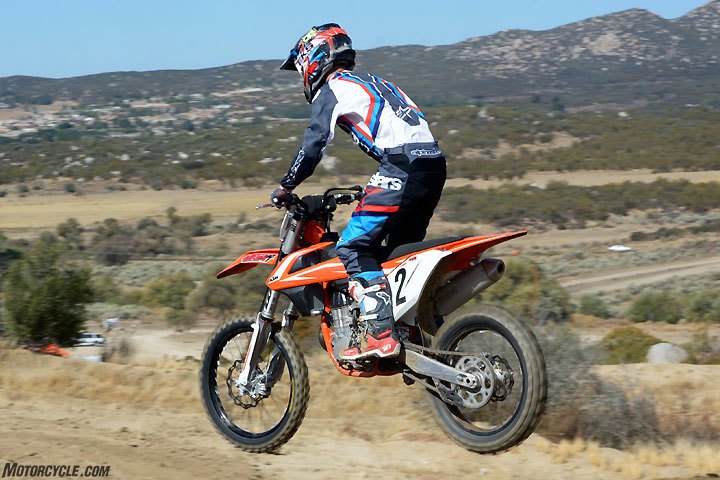 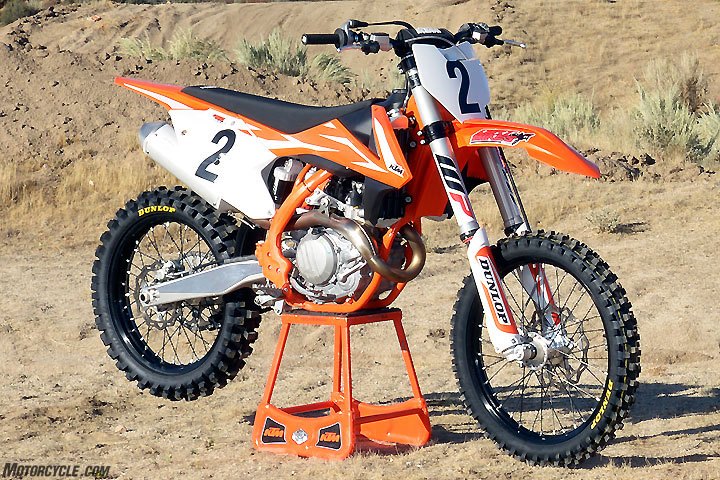 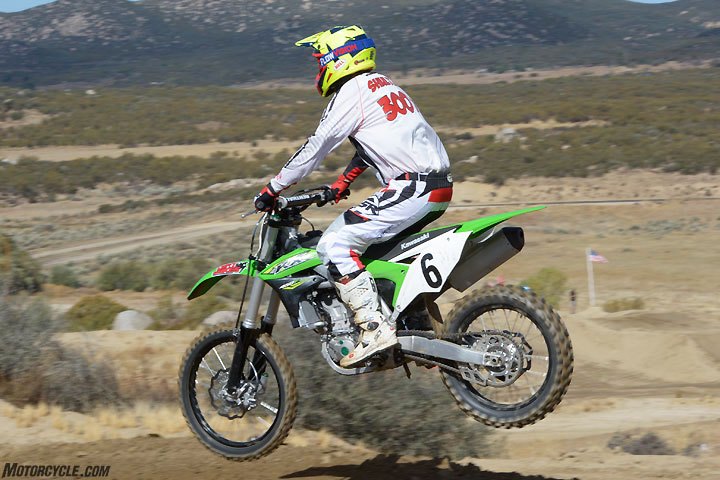 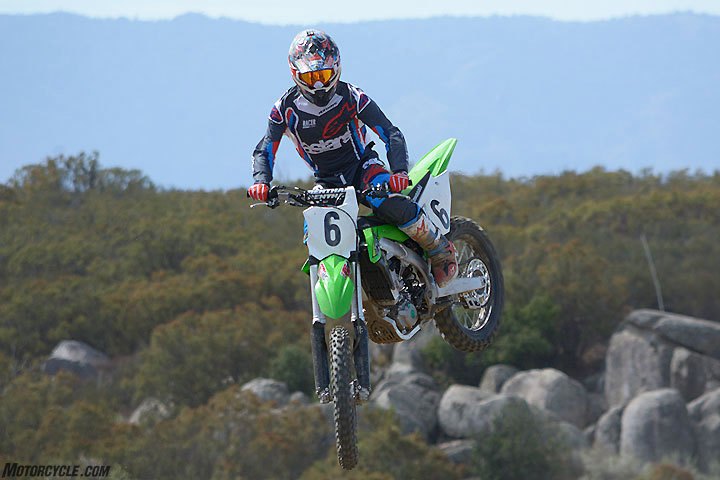 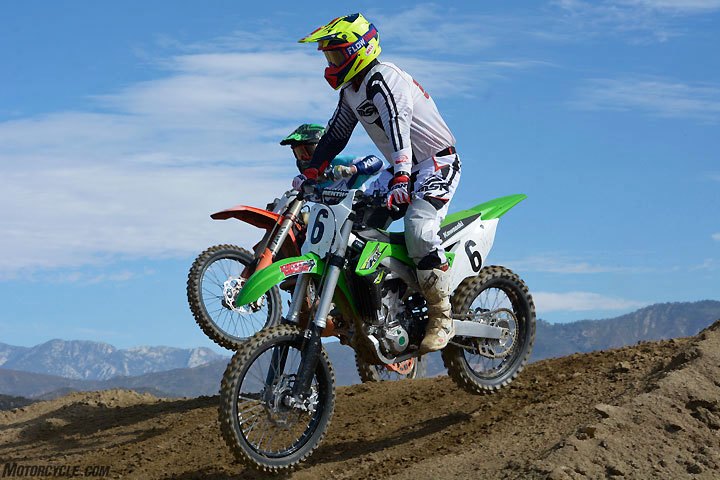 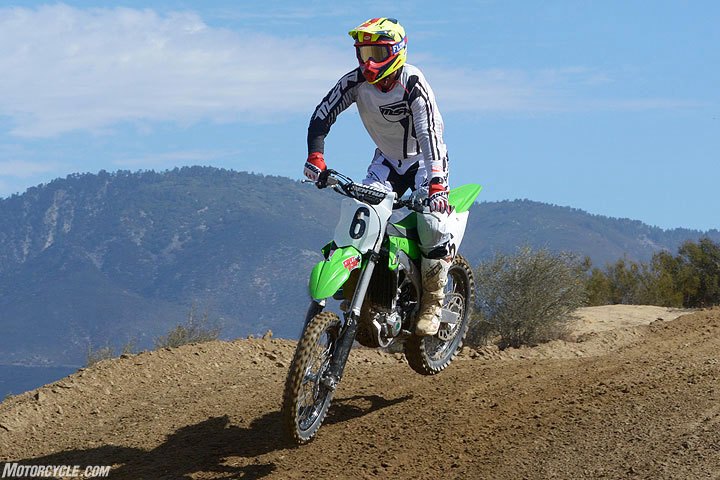 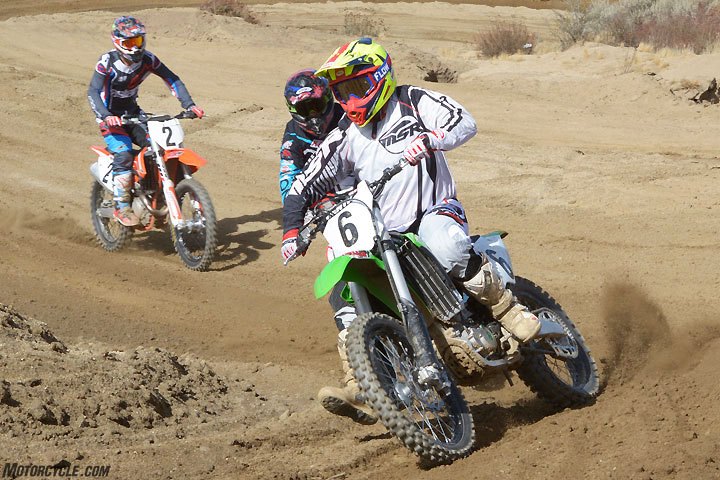 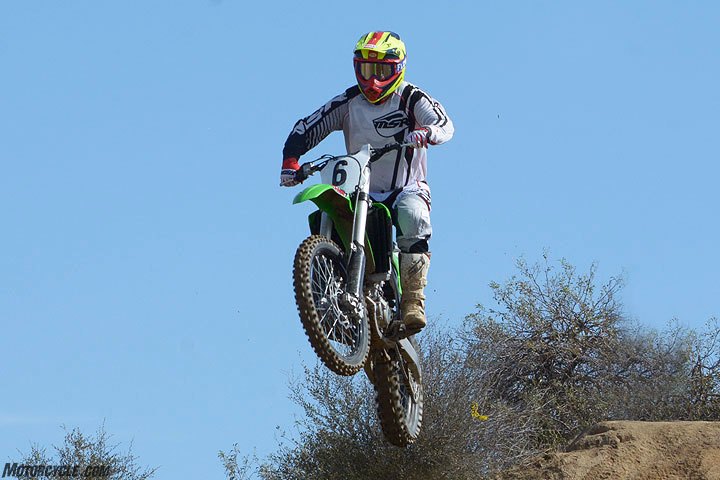 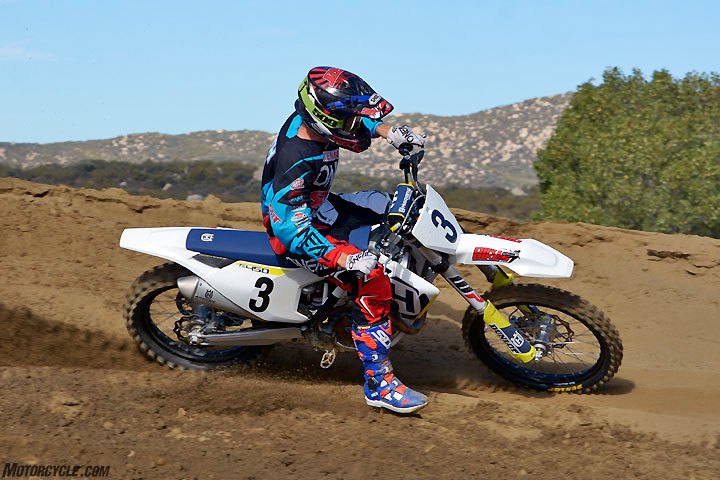 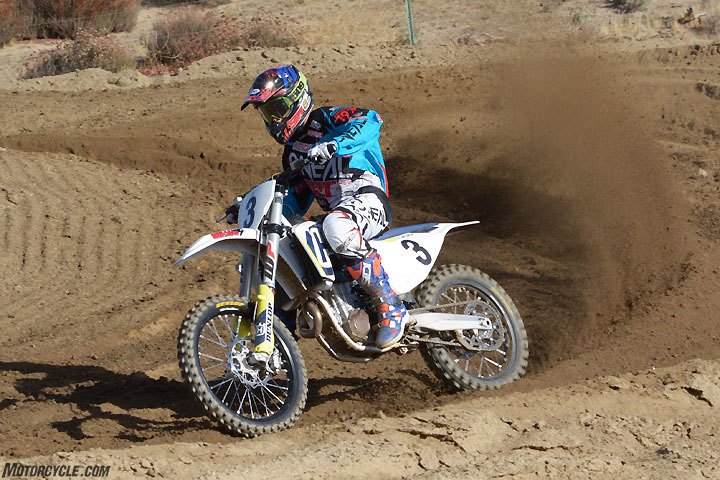 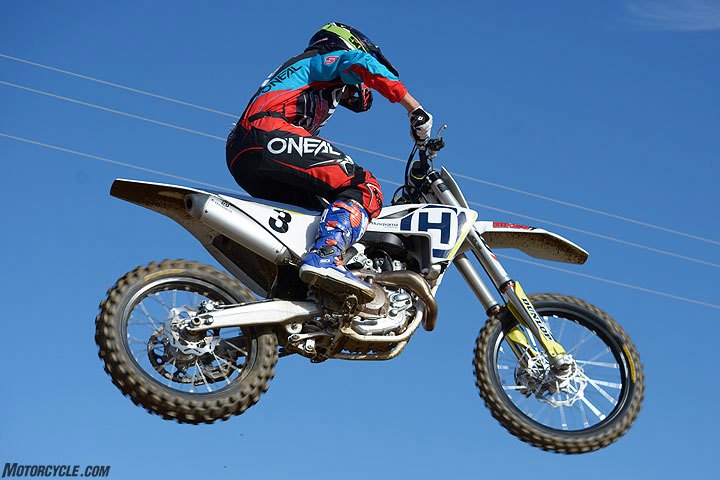 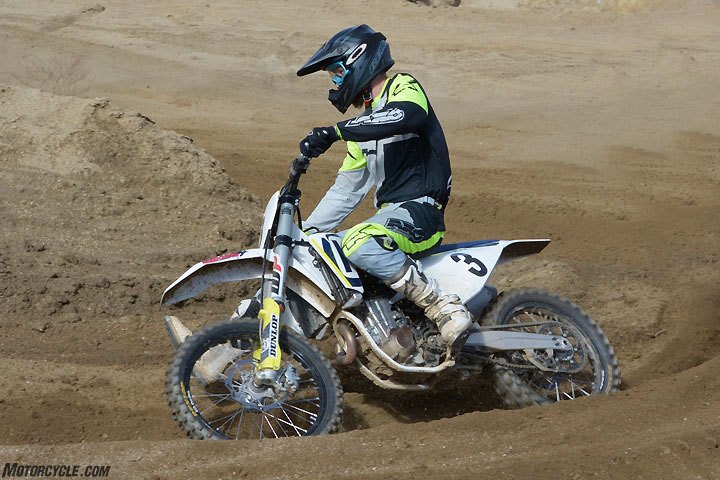 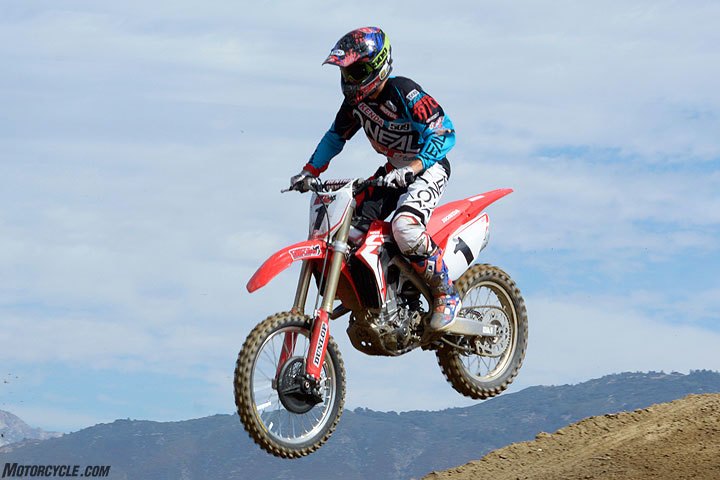 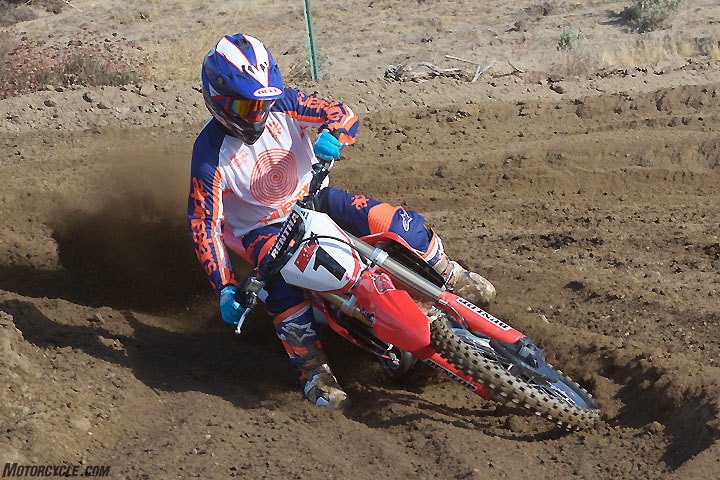 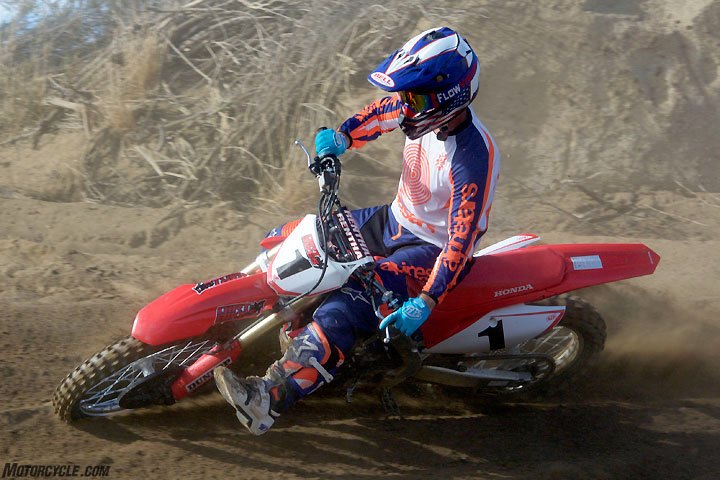 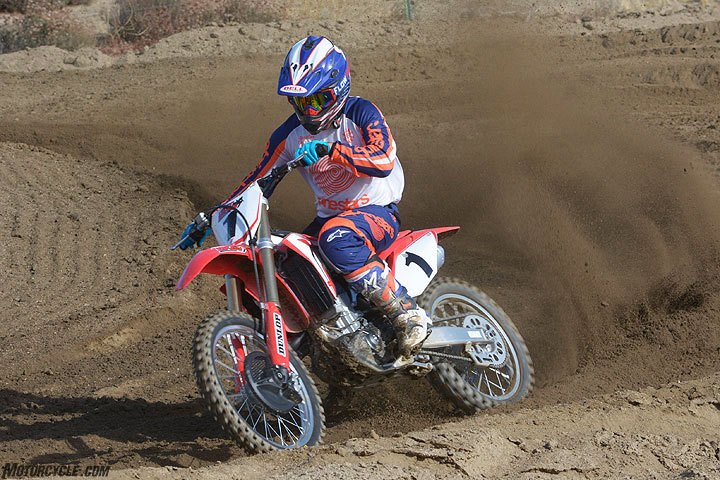 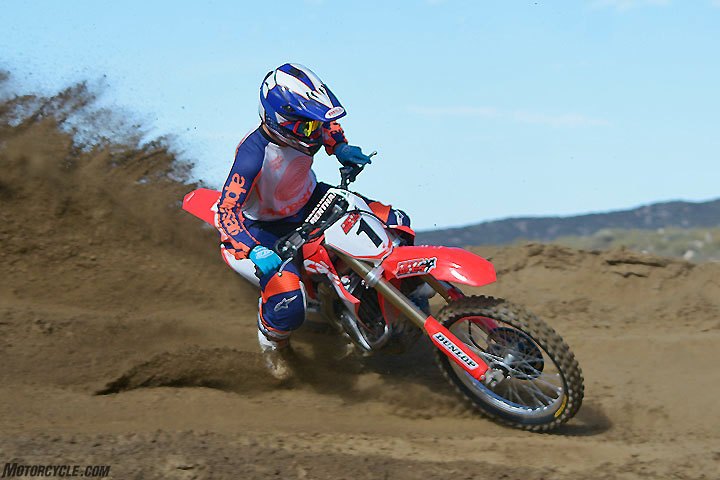 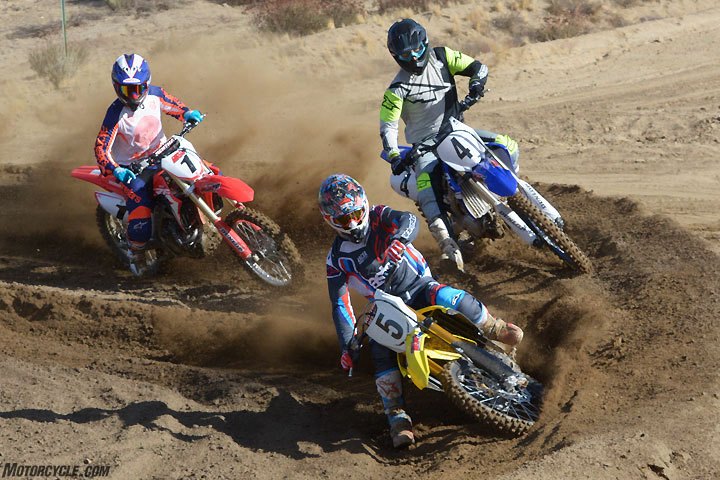 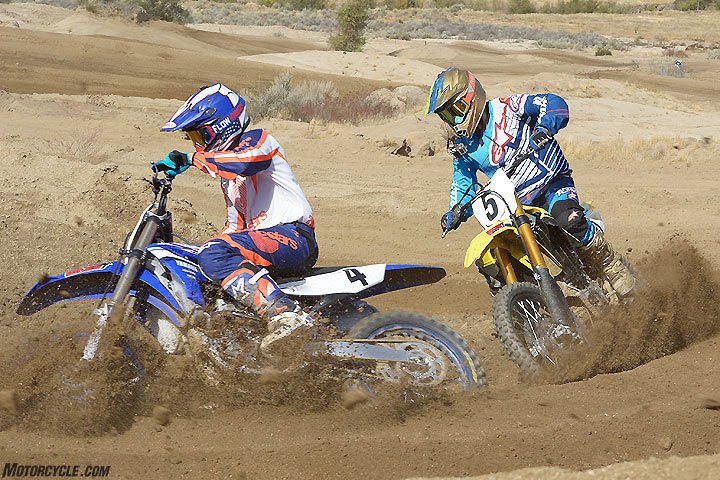 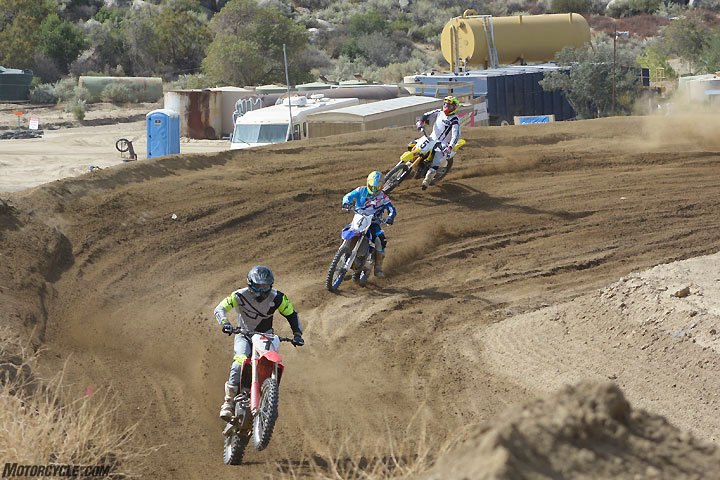 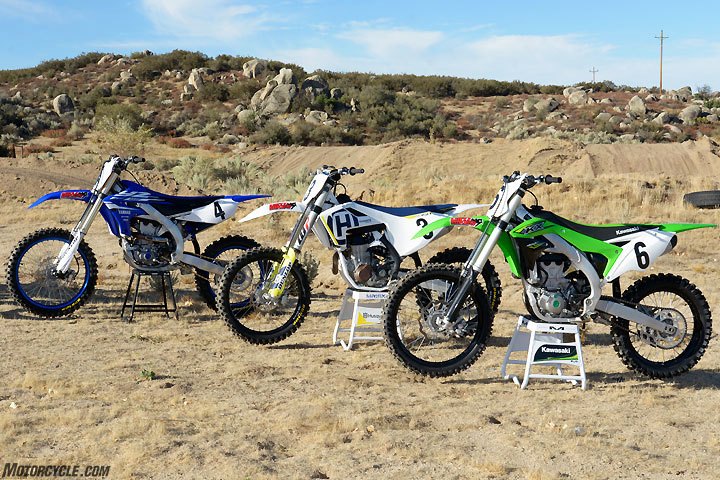  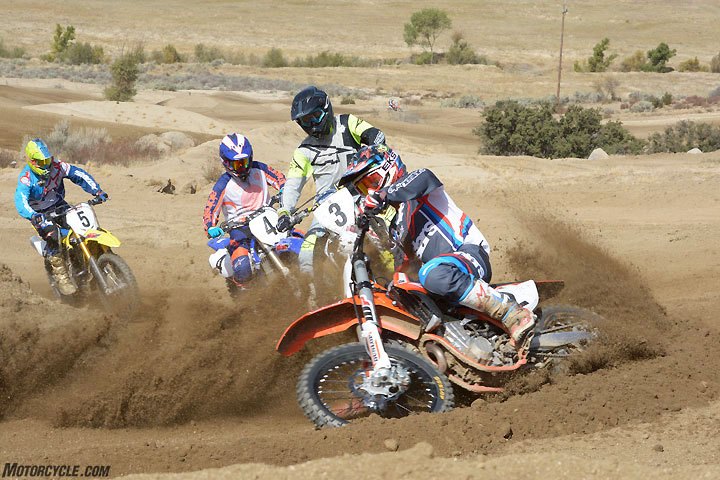 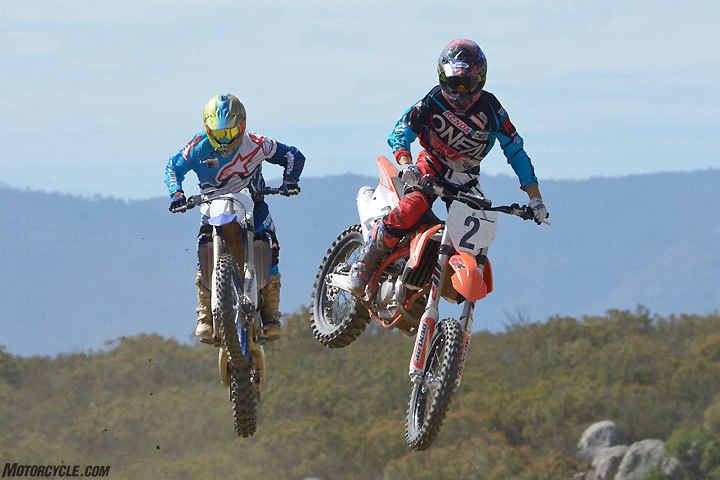 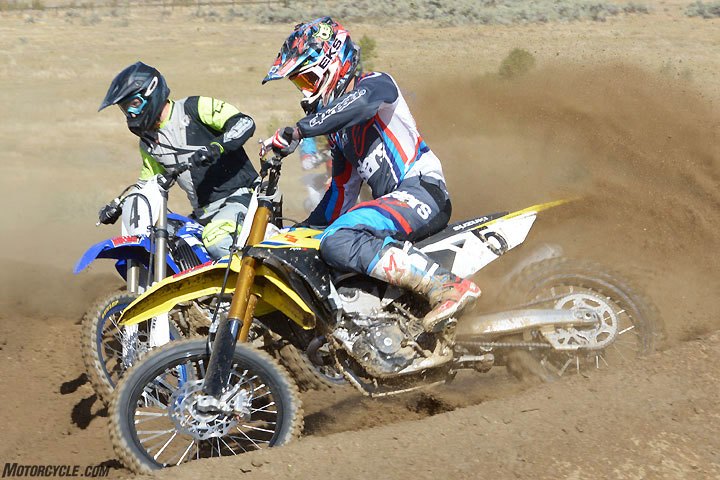 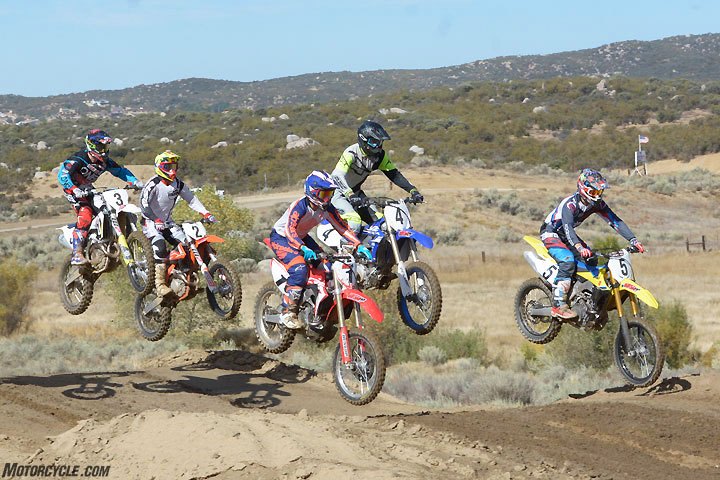 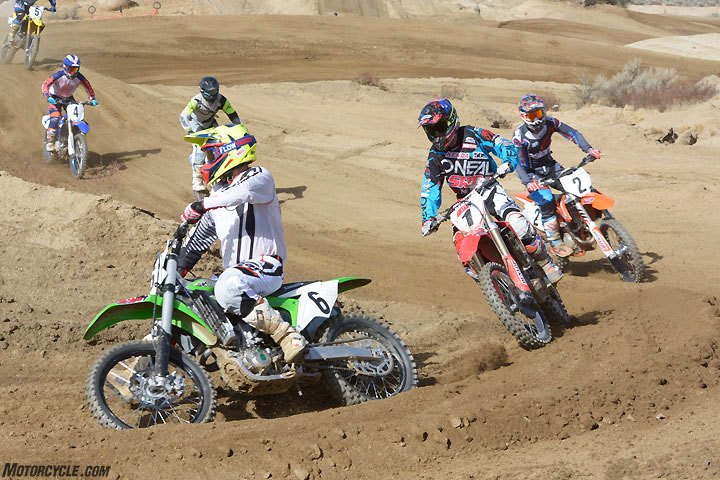 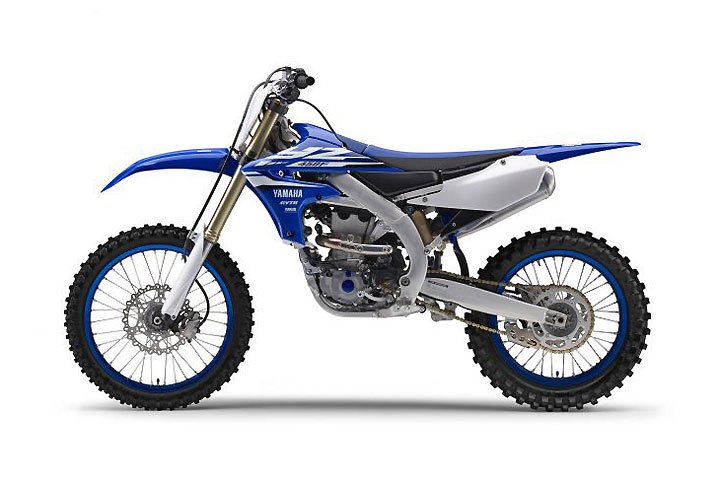 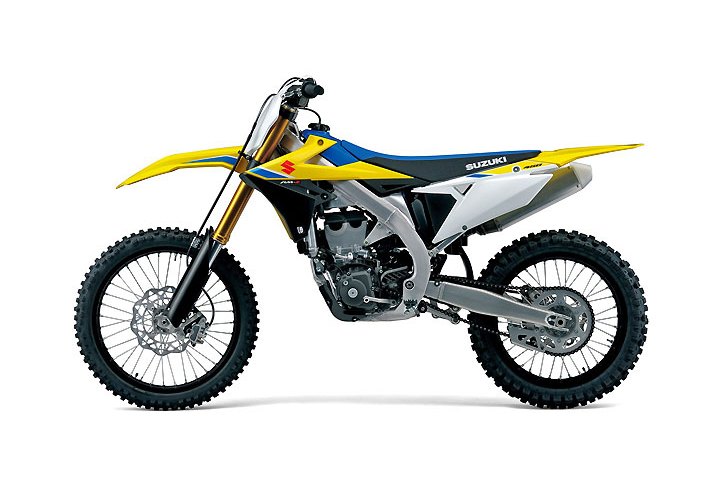 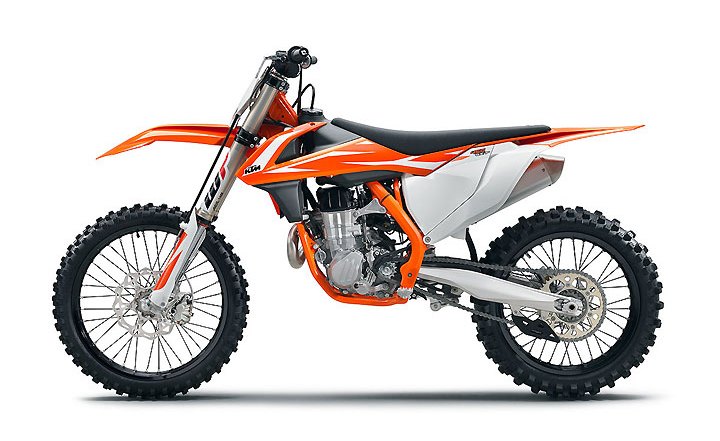 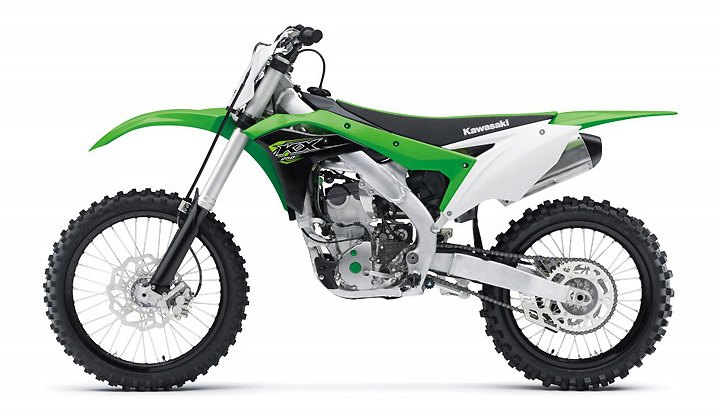 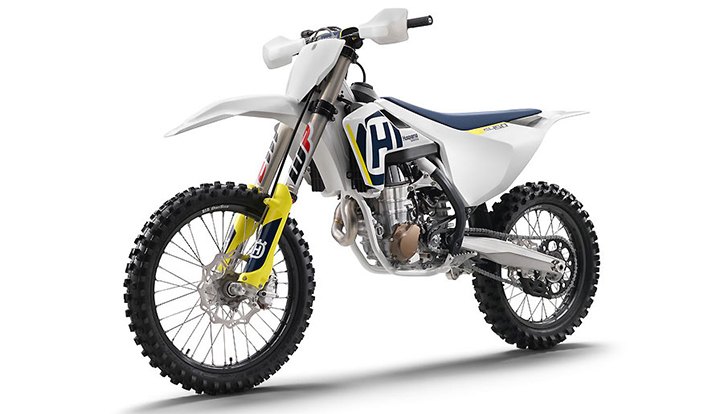 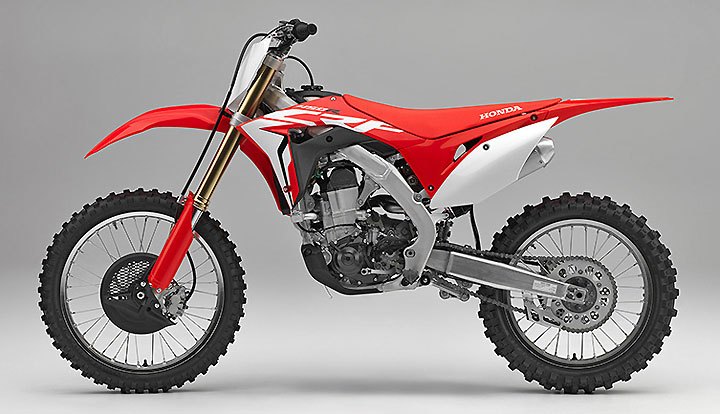 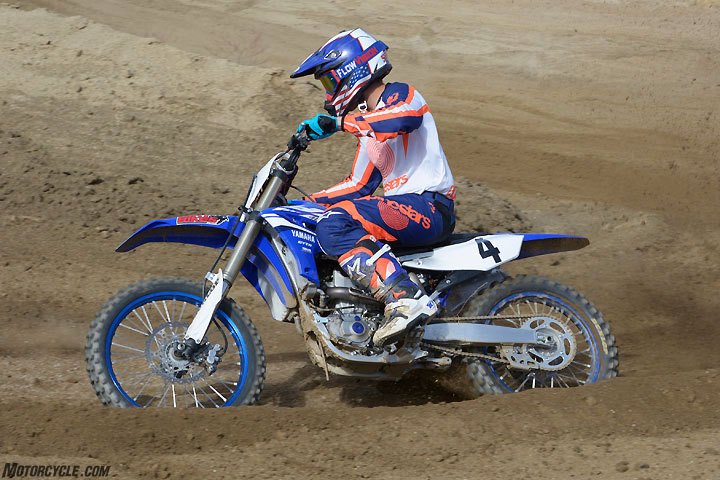 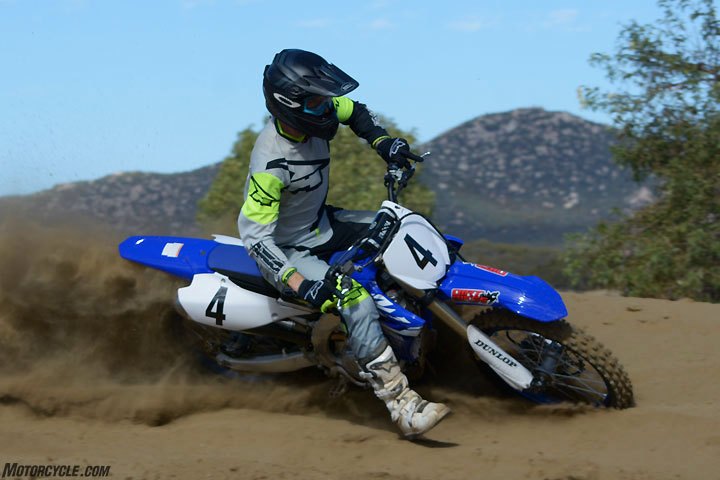 2018 450cc Motocross Shootout appeared first on Motorcycle.com. 2018 450cc Motocross Shootout appeared first on Motorcycle.com.Click here for full story...
__________________________________________________
I'm a bot. I don't need no stinkin' signature... |
|
|

|
 |
 Similar Threads
Similar Threads
|
||||
| Thread | Thread Starter | Forum | Replies | Last Post |
| [motorcycle.com] - RedBud MX to Host 2018 FIM Motocross of Nations | Ninjette Newsbot | Motorcycling News | 0 | October 5th, 2017 04:20 PM |
| [motorcycle.com] - 2017 450cc Motocross Shootout | Ninjette Newsbot | Motorcycling News | 0 | February 8th, 2017 05:11 PM |
| [cyclenews.com] - Issue 49: 2015 450cc MX Shootout, KTM Factory Editions, Talking Mot | Ninjette Newsbot | Motorcycling News | 0 | December 9th, 2014 08:01 AM |
| [motorcycle-usa.com] - 2014 250 Motocross Shootout | Ninjette Newsbot | Motorcycling News | 0 | January 16th, 2014 12:40 AM |
| [roadracingworld.com] - More On Converting 450cc Motocross Bikes To Road Racing Use | Ninjette Newsbot | Motorcycling News | 0 | July 14th, 2009 10:40 PM |
|
|